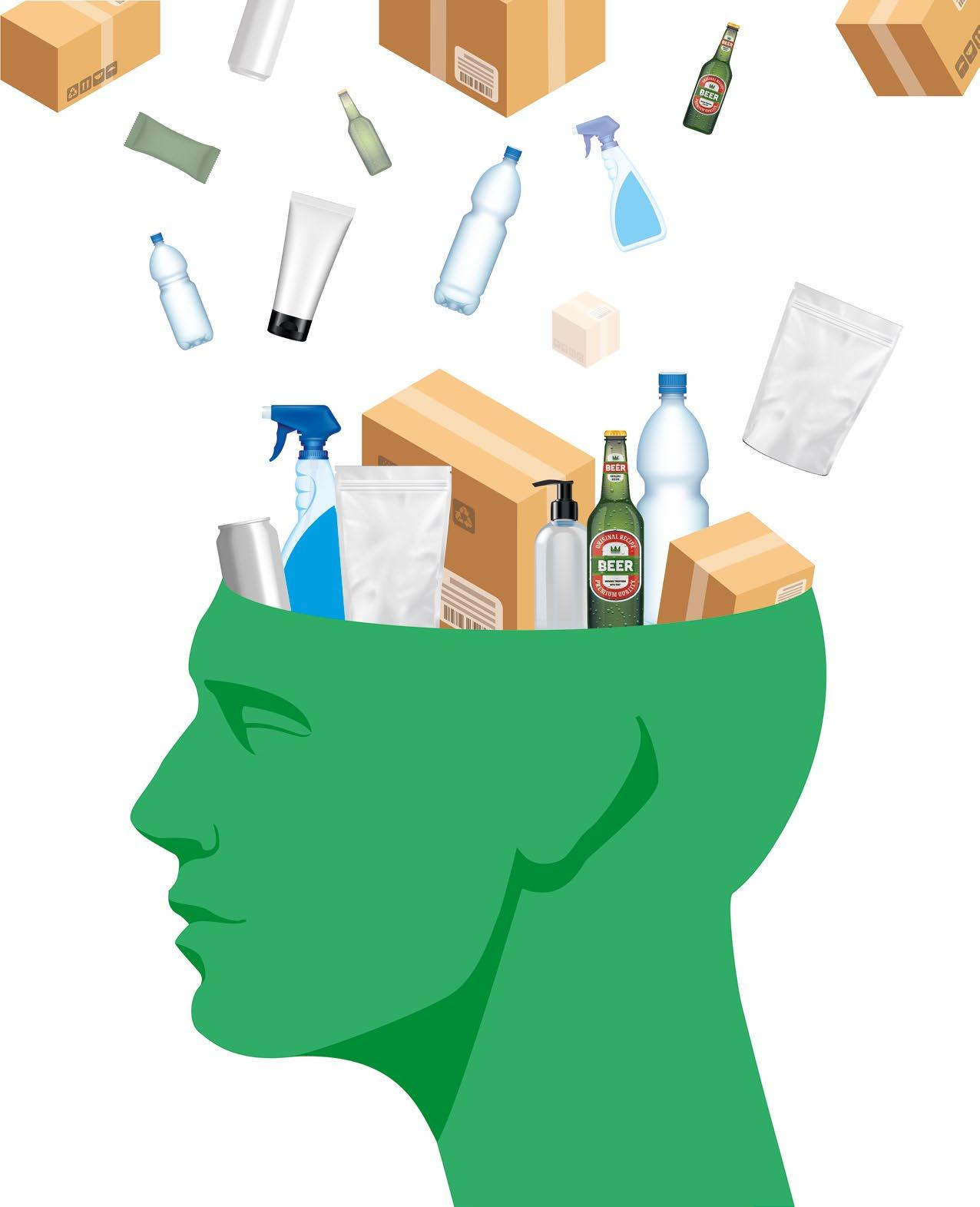
VOLUME 18.3 – 2023 WHAT ROLE CAN PACKAGING PLAY? PROMOTING SUSTAINABLE CONSUMER HABITS REUSABLES • SUSTAINABILITY AND SECURITY • INSPECTION PACKAGING AND HUMAN RIGHTS • LANDA PRINT COLLABORATION

THE CONTENT TEAM
Tim Sykes Brand Director
Victoria Hattersley Senior Writer
Elisabeth Skoda Editor
Libby Munford Journalist
Fin Slater Digital Editor
Emma Liggins Junior Journalist
Frances Butler Junior Journalist
THE PRODUCTION TEAM
Rob Czerwinski Creative Lead
Meg Garratt Digital Design & Production Assistant
Syed Hassan Digital Analyst
THE OPERATIONS TEAM
Amber Dawson Operations Director
Kayleigh Harvey Advertising Coordinator
Simran Budesha Events Operations Manager
THE SALES TEAM
Jesse Roberts Sales Director
Dominic Kurkowski Senior Portfolio
Packaging Europe Ltd

Part of the Rapid News Communications Group

9 Norwich Business Park, Whiting Road, Norwich, Norfolk, NR4 6DJ, UK
Registered Office: Carlton House, Sandpiper Way, Chester Business Park, Chester, CH4 9QE. Company No: 10531302.
Registered in England. VAT Registration No. GB 265 4148 96
Telephone: +44 (0)1603 885000
Editorial: editor@packagingeurope.com
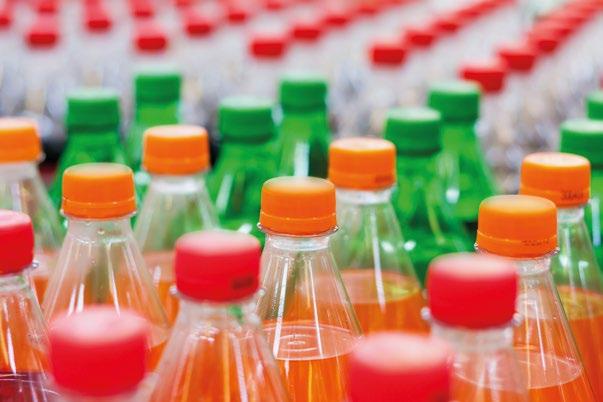
Studio: production@packagingeurope.com

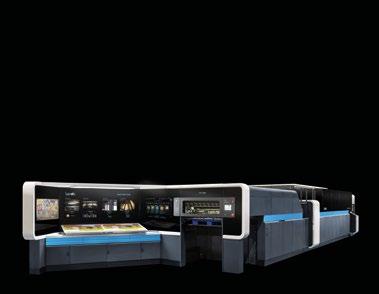
Advertising: jr@packagingeurope.com
Website: packagingeurope.com
Twitter: twitter.com/PackagingEurope
LinkedIn: uk.linkedin.com/company/packaging-europe
YouTube: youtube.com/PackagingEurope
© Packaging Europe Ltd 2023
No part of this publication may be reproduced in any form for any purpose, other than short sections for the purpose of review, without prior consent of the publisher.

ISSN 2516-0133 (Print) ISSN 02516-0141 (Online)
Sales Manager Matt Byron Portfolio Sales Manager Clayton Green Business Development Manager 4 23 37 29 3 Editorial Elisabeth Skoda 4 Understanding consumers Promoting sustainable consumer habits 10 Security versus sustainability Can traceability provide a boost to both? 15 Reuse and refill Focus on cosmetics 20 Weighing and inspection Looking to the future (and the past) 23 Landa print collaboration How this issue was printed 27 drupa preview Focus on packaging print: Looking ahead to touchpoint packaging at drupa 2024 29 interpack review Unpacking interpack: A look back at the 2023 event 33 Rockwell Automation What does the digital transformation mean to packaging manufacturing? 35 Comment Circular packaging and human rights 37 UNESDA A deep dive into packaging sustainability with UNESDA Soft Drinks Europe 40 In Conversation With… A deeper exploration of self-adhesives 42 ESG McKinsey and NielsenIQ reveal broad correlation between on-pack sustainability claims and consumer spending 46 AIPIA stories Active and intelligent packaging spotlight 48 Hive stats Statistics spotlight OUR TEAM CONTENTS

ASI’m writing this, I’ve just returned from this year’s interpack along with the rest of the Packaging Europe team. My feet are still recovering after more than meeting the recommended 10,000 daily steps every day at the Messe. We greatly enjoyed covering the show, exploring the latest innovations and of course meeting many of you. Having our own booth gave us an opportunity to rest those tired feet; the focus of our exhibit was the forthcoming Sustainable Packaging Summit (taking place in Amsterdam on 14-15 November) and we were delighted by the amount of interest we had, the number of people who confirmed they’ll be attending, and by the passionate discussions the program is already provoking. Read more about the team’s digest of our interpack impressions further on in these pages.
Speaking of the pages of this magazine, you may notice something special about the print quality of this month’s edition. This is because we’ve collaborated with Landa to print the magazine on a Landa S10P Nanographic Printing® Press – you can read more about this project in the centrefold.
CONTACT ME
Elisabeth Skoda · Editor at large es@packagingeurope.com

Also in this edition – understanding consumer purchasing behaviour is one of the key factors for brands when it comes to deciding what to sell and how. But how can we ‘sell’ sustainable behaviour? Victoria Hattersley asks how a greater understanding of consumer behaviours and motivations can help build a more sustainable supply chain in our big feature.
Staying on the subject of consumer behaviour, we take a deep dive into a joint study by McKinsey and NielsenIQ that explores the relationship between ESGrelated claims made on product packaging and consumer spending habits with the goal to find out how companies can balance sustainability-minded progress with commercial success.
interpack 2023 is done and dusted, but the next big event in Düsseldorf is just around the corner. A year ahead of drupa 2024, where we’ll be supporting the special touchpoint packaging project, I talk to the organizers to explore industry megatrends impacting print and printed packaging.

Frances Butler zooms in on the reuse and refill market and finds out what advancements and new developments there are in the toiletries and cosmetics packaging sector. Emma Liggins takes an in-depth look at whether traceability could serve as a solution to address both sustainability and security challenges in the future. Meanwhile, Fin Slater discusses innovations in the area of weighing and inspection and shines a spotlight on some of the developments that were shown at interpack 2023.
Also in this issue, I interview UNESDA Soft Drinks Europe’s Director General Nicholas Hodac, and we discuss the state of the drinks and drinks packaging market as well as progress towards the association’s circular packaging vision for 2030.
We also have a comment piece from Alina Marm, who on top of her role at packaging ink and coating specialist Siegwerk, is a PhD researcher at the University College London. She sheds light on people who are often overlooked in the packaging recycling process and explains why we must pay attention to human rights when scaling up the use of recycled content, and how unintended consequences can be avoided.
All that remains for me to say is that by the time you receive this magazine, the finalists for our Sustainability Awards 2023 will have been announced –head over to packagingeurope.com to find out who they are if you haven’t done so yet. Winners will be announced at a special dinner and networking party at the Sustainable Packaging Summit. We hope to see you there, and in the meantime, we welcome you to our upcoming virtual panels and hope that you enjoy this latest edition of the magazine.
Elisabeth Skoda
3 Packaging Europe EDITORIAL
@PackEuropeEli
n
‘SPEAK THE SAME LANGUAGE’: PROMOTING SUSTAINABLE CONSUMER HABITS
WEknow that understanding consumer purchasing behaviours is key for brands when it comes to deciding what to sell and how. But it’s not all about the bottom line anymore. Far more important is how the wider packaging value chain can ‘sell’ more sustainable behaviours.
So what kinds of environmental issues do consumers, in the broader sense, prioritize today, and how do they view ‘sustainability’ when it comes to packaging? Unless we have been living off-grid, we’re all aware, for example, of the recent negative perceptions of plastics and resulting move towards paper-based solutions. However, according to Richard Cope, trends consultant at Mintel and author of the company’s 2023 Global Outlook on Sustainability report, the average consumer may now be starting to understand there are more facets to the issue.
“When we survey consumers about their priorities, a major concern is that the package protects the product itself inside rather than what it is
made of. After that, closely behind, they say it’s important packaging is low impact and that it can be recyclable, but that’s really a secondary concern. In recent years, I think a lot of our clients and brands had been getting frustrated that consumers didn’t realize things were wrapped in plastic for a good reason. I think that is starting to change.”
That is not, of course, to say that plastic waste is no longer an important issue: quite rightly, there is widespread recognition that we need to both reduce the amount of unnecessary plastics we use and transform our recycling infrastructures – but it’s positive to also see a gradual shift towards understanding that reducing carbon and ensuring resource efficiency, as opposed to plastic, may be equal if not bigger concerns.
However, one problem with asking consumers how they feel about sustainability is that what we say and what we do can be very different things: the ‘value-action gap’. The above-mentioned Mintel Global Sustainability Report found that, when surveying consumers, the gap between them agreeing with
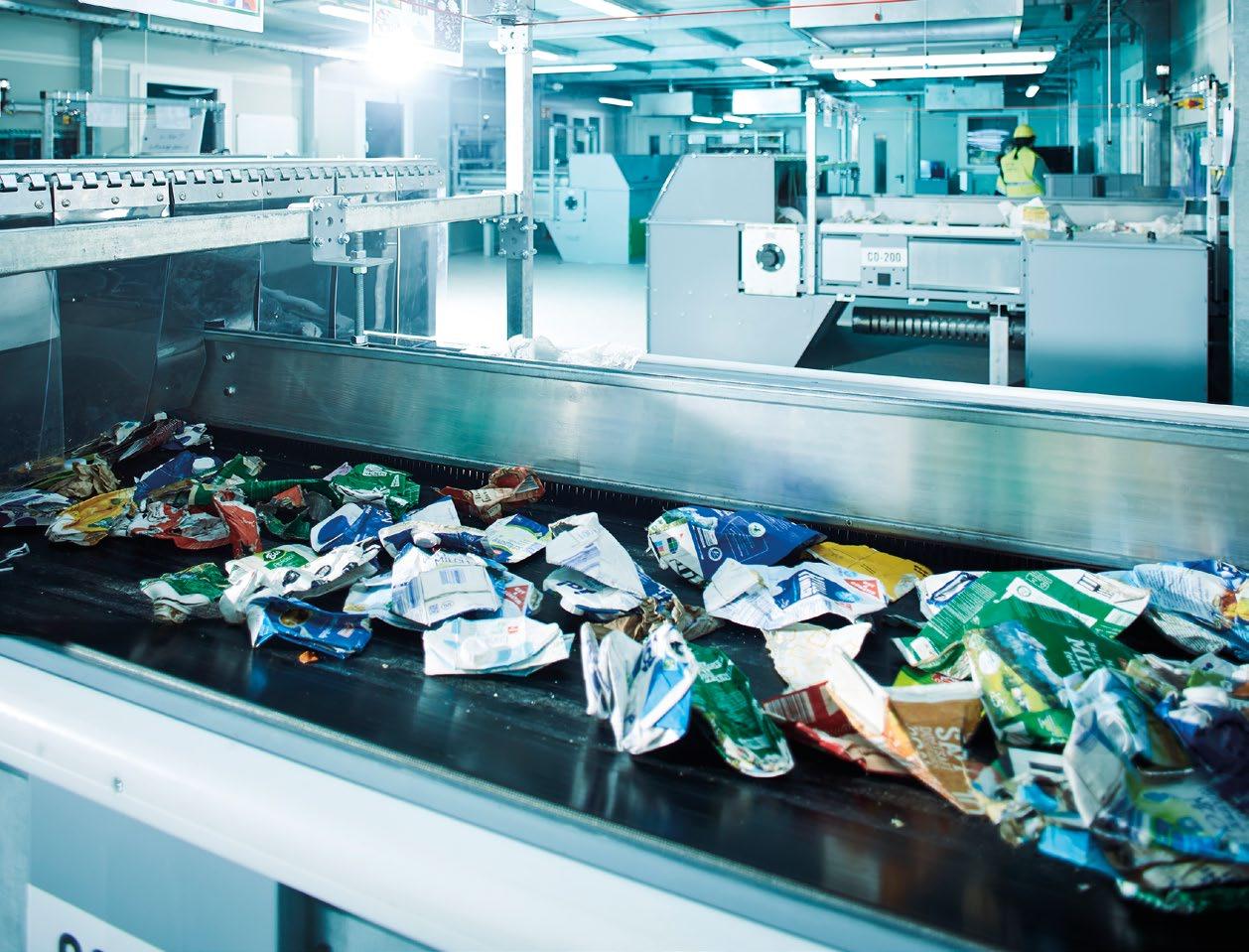
4 Packaging Europe
How can a greater understanding of consumer behaviours and motivations help build a more sustainable supply chain? Victoria Hattersley reports.

statements such as ‘I try not to be harmful to the environment’ and actually performing very simple and costless (to them) tasks such as recycling packaging is a very significant 23 percentage points.
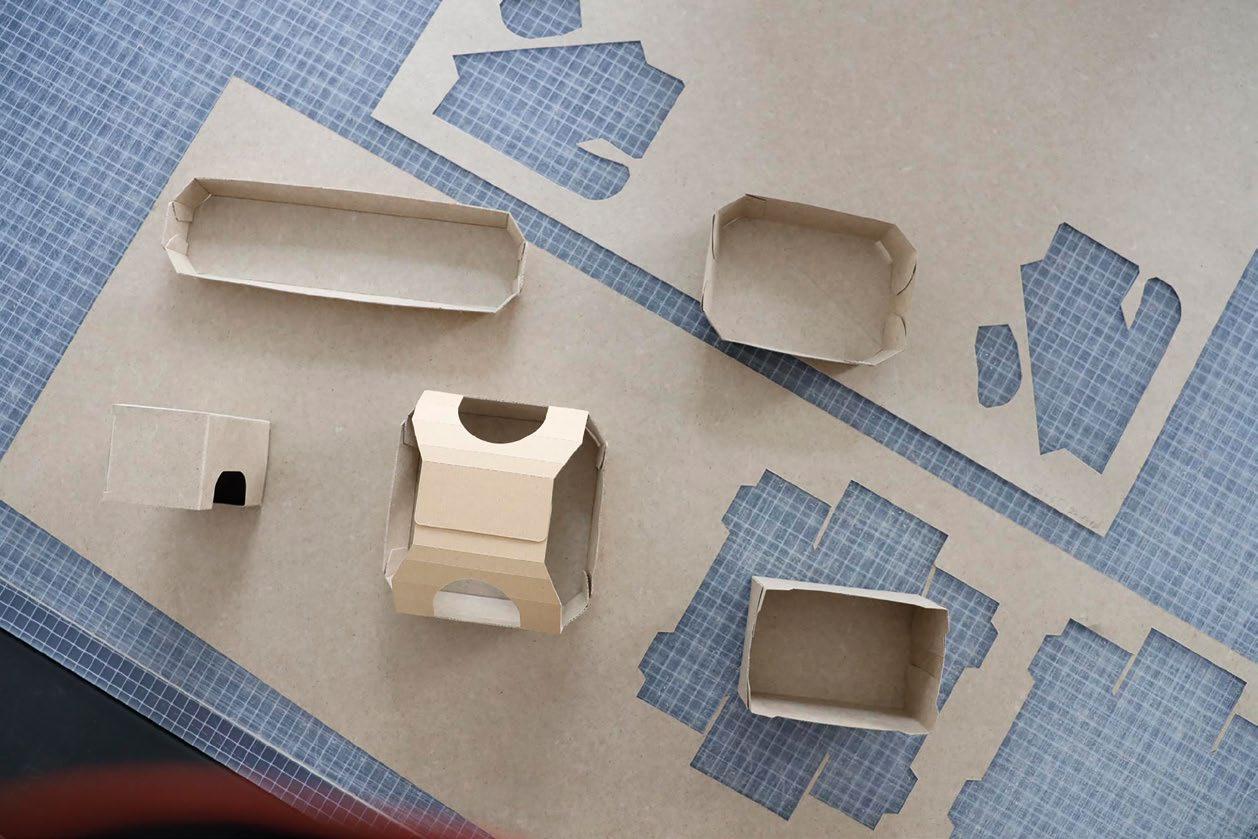
Rebuilding consumer trust
So how can brands and retailers use what they know about consumers to promote more sustainable behaviours? For starters, says Alexander Reitz, Team Lead at PreZero Sustainable Packaging, there are major issues with labelling that need to be addressed. At the moment, many on-pack labels are far too unclear and this can lead to apathy when it comes to recycling.
“Labelling has to be improved and standardized. When it comes to the separate issue of recyclability guidelines it’s too complex because each country has a different set of rules of what is recyclable and what is not, which can be confusing for brand owners. But recyclable packaging is a prerequisite for a functioning circular economy. To quickly and reliably determine the recyclability of packaging and to help manage the complexity of different standards and guideline, PreZero will launch at the beginning of June a specially developed software tool. Companies and organizations can use it and more easily create sustainable packaging solutions.”
The need for clarity when it comes to packaging also draws us into the rather knotty question of transparency on the part of brand owners, as this is perhaps where consumer trust has been eroding the most. According to Mintel, over a third (38%) of consumers don’t trust companies to be honest about their environmental impact.
Part of the problem, says Richard Cope, is that “brands are often guilty of communicating to consumers in metrics they can’t comprehend and that is where a lot of the cynicism comes from. Speak the same language and be honest about where you are.” One option, he says, could be the use of clear ‘eco-scores’ similar to those which already provide nutritional information for food – whether directly on-pack or using QR codes.
“Brands like Levi’s do a good job of saying how much water they use, for example, and explaining their targets and how far they have come to reaching them. That approach is OK. It’s fine to admit that you’re still on a journey but what you can’t do is sit around and wait to be attacked for doing nothing.”
It’s also fair to say that people are becoming wary about the notion of carbon offsetting. As a concept, it’s a nebulous one to say the least. “It’s outsourcing rather than taking action to change what you’re doing and throwing money at the problem,” as Richard says.
So there’s an element of ‘borrowing from Peter to pay Paul’ when it comes to practices such as offsetting?
“Yes, absolutely. We’re still in an era where brands are trying to say they’re environmentally friendly and that’s dead as a concept. There’s no such thing as an ‘environmentally friendly’ brand because everything we do has an impact. Instead of making outrageous claims (e.g. Lufthanza claiming they’re environmentally friendly when they’re an airline!) brands could be communicating that they are choosing a certain material because it reduces a certain percentage of emissions overall.”
6 Packaging Europe
Whose responsibility is recycling?
Another area of confusion for consumers around packaging is around the responsibility for package recycling or disposal – whose is it? When it comes to questions such as renewable energy transitions, the answer is simple: the government must take responsibility. With packaging, it’s often brand owners who are perceived as holding the responsibility even if this is not necessarily the case. It’s true that some companies, like Amazon, are now putting money into developing their own recycling infrastructure, but they are still the outliers.
“Obviously there’s a disconnect somewhere,” says Richard Cope. “I get annoyed we can’t recycle Tetra Pak where I live, but is that their responsibility? The government? I think regardless, as a company you start to lose credibility with consumers if you’re putting something on the market that is technically recyclable but not actually recycled in practice.”
In other words, the brand owner’s role in the circular economy can’t stop at the point where their product enters the market. But it would be naïve to rely on a company’s sense of moral fair play in this regard; what is really needed is some kind of legal framework for them to adhere to.
Richard suggests that one way of encouraging consumers to take a more active role in the recycling process themselves would be to harness the (sometimes ugly but undeniable) power of national pride. Never underestimate the power of patriotism.
“There can be a lot of pride around products that are ‘made in Britain’, for example. But what about ‘recycled in Britain’ being a badge of honour rather than it being shipped off somewhere else or put into landfill? What if all countries were to adopt this approach?”
Scaling up reuse

We know that there are also increasing calls for companies to step up reusable/refillable packaging models. Yet so far these have been largely unsuccessful. Why is this, and how can a greater understanding of consumer behaviours and priorities help to develop more successful reuse models in future?
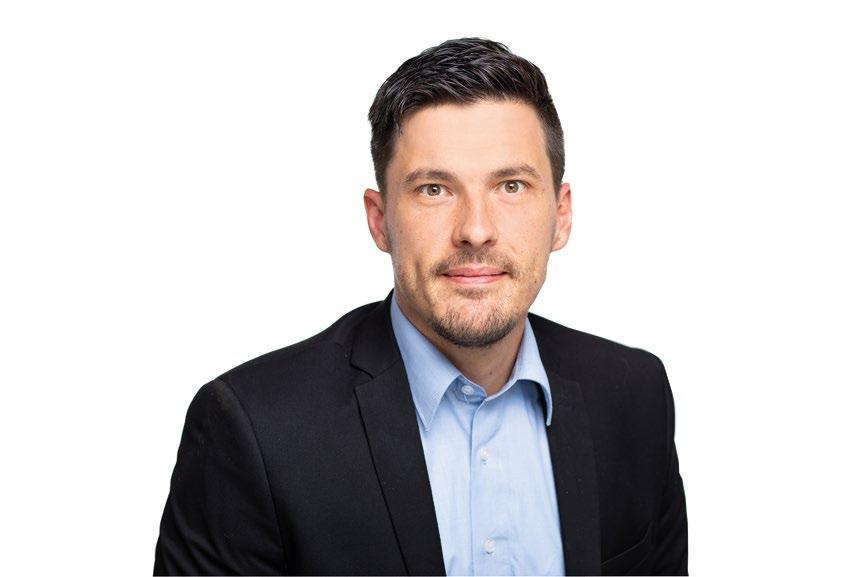

“It’s partly a hangover from the pandemic and the (mistaken) idea that single-use is still more hygienic,” says Richard. “More broadly, I guess it’s just not very convenient still. You’ve got to go on a journey to take the

Packaging Europe
Alexander Reitz
Team Lead at PreZero Sustainable Packaging
7
Richard Cope Trends consultant at Mintel
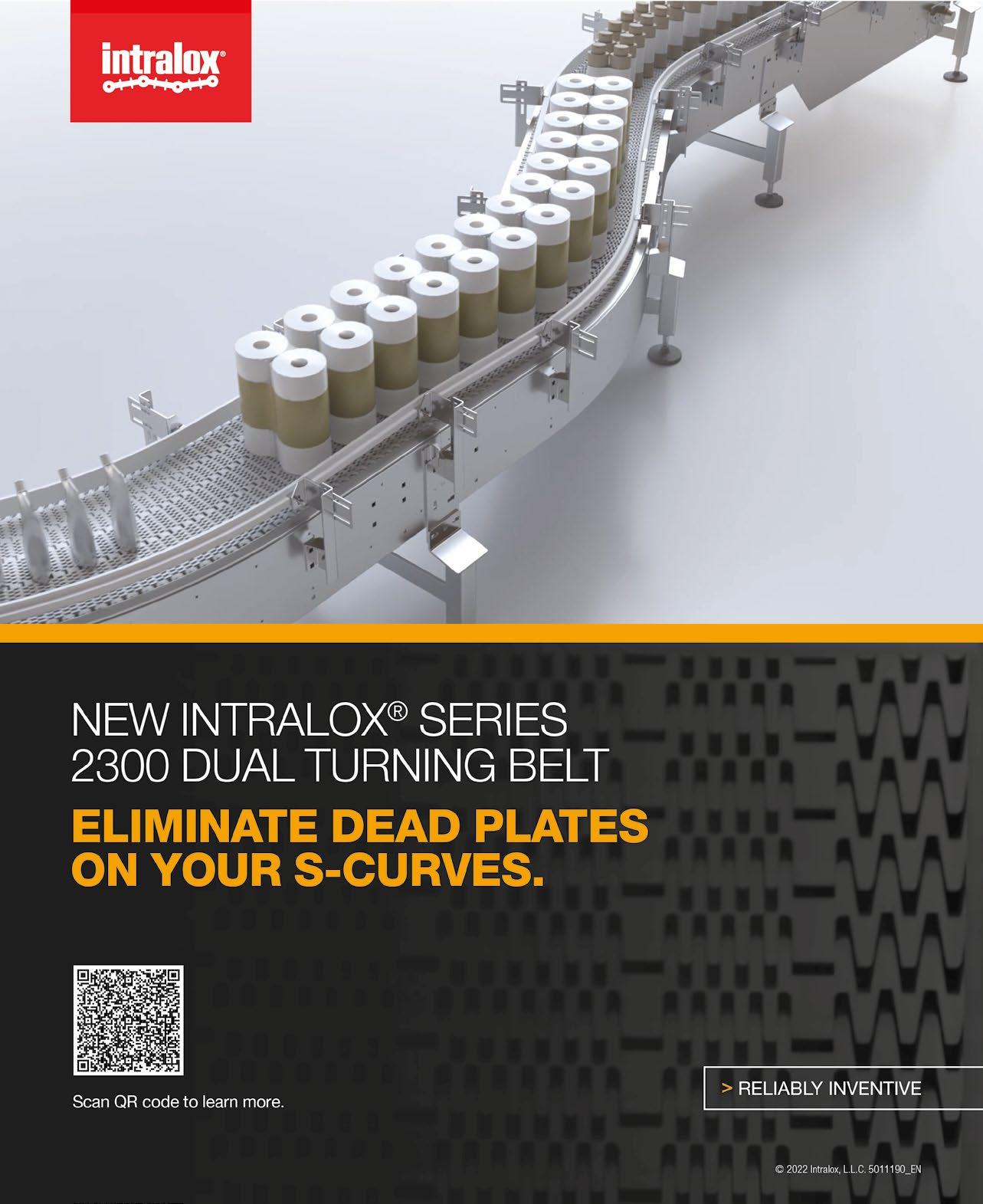
level of convenience. I believe reuse might take off more widely if it is integrated into e-commerce grocery deliveries. We have seen this to some extent with the Loop system, but that is a more ‘premium’ model.”
Furthermore, Alexander Reitz says we should reject the notion that reuse is always more sustainable as it really depends on context. For example, cleaning containers after each use adds to the pack’s overall water footprint and additional emissions for transportation have to be taken into account, so it is only more environmentally beneficial if the alternatives have even greater environmental impact. As ever, it comes down to examining each individual case. It’s no wonder the ‘right’ system can take so long to implement.
Where are we with smart packaging?

We drifted earlier into the area of smart packaging when we discussed the possibility of providing consumers with clearer information on packs using QR codes. But while there are big possibilities for smart packaging technologies these have not, as yet, hit their stride when it comes to reducing environmental impact. Ultimately, many technologies such as AR may still be perceived by many consumers as ‘gimmicky’.
“I honestly think it’s fundamentally not a convenient thing,” says Richard Cope. “If you can just print simple eco-scores on the pack that would give the consumer the information they need, why complicate things?”
That’s not to say there aren’t areas in which smart technologies couldn’t make a huge difference to efficiency and circularity – we just may have to accept these aren’t all necessarily consumer facing.
“I don’t think consumers have time to scan codes, but smart technologies could certainly be helpful further down the value chain in areas such as sorting plants, for example.” The HolyGrail project, which uses digital watermarking technologies to sort packaging waste, is an obvious candidate here.
Alexander Reitz does however point out one possible use for VR in particular. “If you could get consumers to take VR tours of sorting plants to
tion and maybe even change behaviour.”
It’s about the overall impact
In future, it’s clear consumer messaging needs to be far more transparent and focused on educating about the overall carbon impact of a product. Both Alexander and Richard believe there is still too much emphasis on what is happening to the packaging at the end of the product’s life – understandable, perhaps, as the package is a tangible thing we have a level of agency over when disposing of. But they also feel consumers should be educated about the energy and resources that are consumed further up the supply chain, right up to the point of production.
Alexander expressed concern that there may already even a certain amount of ‘apathy’ on the part of consumers when it comes to the topic of sustainability itself. After all, attention spans can be short.
“Sustainability must be the main focus for the foreseeable future, above all else. I wish we weren’t always looking for the ‘next big thing’ rather than focusing on what we need to do now.”
Rather than seeing them as an ‘other’, separate group, perhaps brands need to recognize that there are strong similarities and overlaps between their own motivations and those of consumers. To borrow a quote from the Mintel report:
“People like to be perceived as healthy, considered and informed in their choices, as well as community orientated, but the reality gaps here are often equally as wide. The simple, actionable conclusion is that people are extremely image- and reputation-conscious, and like to portray themselves as ‘good’ and be perceived as ‘good’. In that regard, they are no different from many brands and their motivations for being sustainable. Making people feel – and look – good has to be a marketing goal.”
Quite simply, brands need to consider how, rather than making themselves and consumers look good, they can be ‘good’ through the positive actions they take. n
9 Packaging Europe
CAN TRACEABILITY BOOST BOTH SECURITY AND SUSTAINABILITY?
As traceability becomes a more prominent talking point at both an industrial and legislative level, Emma Liggins explores whether this approach could serve as a solution addressing both sustainability and security challenges in packaging in the future.

Traceability is an essential facet at all stages of the packaging value chain. At the Rockwell Automation Fair in 2022, vice president and chief IP counsel John Miller and director of revenue and brand protection Ryan Smaglik noted that global supply chain disruptions are limiting stock availability; that increasing pressure on procurement professionals is incentivizing them to consider unauthorized sources; and that deceptive business practices seem to have increased opportunities for counterfeiters and unauthorized resellers.
Thus emerge the dangers of the so-called ‘grey market’, wherein misleading claims of 24- to 48-hour delivery or plentiful stock, or outright false claims that the seller is authorized or buys from authorized sources, can lead to the sale of automated products without the appropriate warranties and licensing for software or firmware – as well as potentially exposing customers’ systems to security and safety risks or breaching mandatory certifications, directives, marking requirements, or regulations.
Beyond the automation space, packaging itself can fall victim. Incorrect or modified packaging can impact a brand’s reputation and harm its market performance. If, for instance, the packaging displays incorrect instructions for the use of the product, it can damage perceptions of a brand’s authenticity.
Nor is it only industry players at risk – inaccuracies of this kind could cause inconvenience at best, and danger at worst, for consumers. An insights survey sponsored by Digimarc and conducted by Censuswide saw 39% of respondents report that they had unknowingly purchased a fake product at some point. 67% were concerned about the authenticity of the products they buy for their homes and families, while 64% worried about the efficacy and health and safety risks, including potential toxicity, of a counterfeit product.
NFC, RFID and beyond
Anti-counterfeiting solutions are already on the rise, but they are not without their flaws. Barcodes were first patented in the USA over 70 years ago and, while they can effectively trace a product’s movement throughout the supply chain, they cannot guarantee the legitimacy of the product itself, especially when it is possible to fake them. Such can even be the case for more recent alternatives, like QR codes and holographic adhesive labels.
Authena AG tells us that faking products not only impacts companies through lost revenue but also leaves room for forced and exploitative labour in direct contradiction with global ESG goals. The company offers one solution – near-field communication (NFC) technology. With the tap of a smartphone, consumers can access authenticity and ownership certificates via cryptographic non-fungible tokens (NFTs) associated with a physical twin through Authena’s M3TA blockchain technology. In turn, companies can track products at all stages of the supply chain.
In general, though, NFC is an imperfect solution. It is a low-speed and expensive method that some users may find confusing, and with the hacking of phone data on the rise, it does not guarantee complete security.
Radio frequency identification (RFID) tags serve as an alternate option that claims to tackle some of these issues. Alastair Hanlon, CCO at PragmatIC Semiconductor, told Packaging Europe that these tags are difficult to copy and hard to damage beyond the point of readability, unlike barcodes. Large batches of RFID-tagged items can be read at the same time, and these tags can be positioned beneath a label without impacting their readability.
10 Packaging Europe


Not everyone agrees with these perks. Sagitta HPC’s COO Emily Mitchell told Business.com that only a smartphone is needed to clone RFID tags and, in her example, pay for one product at the cheaper price of another. Nor do RFID tags stop tracking at the point of purchase, she explained – so long as the tag is attached to a pack, the recorded data can theoretically be linked to specific purchases on a credit or debit card, or even a loyalty discount card, and track a consumer’s movements throughout a shopping complex.
Focus on e-commerce
Perhaps this particular issue is less of a concern for e-commerce applications, although its longer supply chain arguably creates more opportunities for theft, tampering, and loss. Currently, Amazon’s solution is its Transparency product serialization service, which utilizes unique and secure codes to ensure that individual units can be identified. By restricting its listings to products featuring a valid Transparency QR code, the company aims to prevent counterfeits from reaching customers.
Even when an item has been delivered, its code can be scanned via the Amazon Shopping and Transparency apps to confirm its authenticity and access content provided by the sellers in a bid to improve customer engagement. Participating sellers can also use the resultant data to optimize their supply chains by gaining insights at batch or lot level, thus identifying issues and their root cause to implement solutions with minimal disruption. Jorge Hernández Jimenez, general manager at electrical equipment supplier OcioDual, reports on Amazon’s website that the solution has increased his company’s revenue by 30% and eliminated any infringement attempts on the company’s products.

Traceability becomes a useful asset in such extreme cases as counterfeiting, but also for less drastic issues – product recalls, issues in the distribution process, or even positive circumstances such as gathering sales data and targeting marketing campaigns to specific consumers. Another important motivation behind improving traceability, though, is an ongoing push for sustainability.

Gathering data
Last September, McKinsey published a report suggesting that fewer than 30% of organizations had clear metrics surrounding recyclability, sustainability, or recycled content to hand. Without this information, consumers must take a brand’s word for its sustainability metrics – and, given that accusations of greenwashing have not slowed in the past few years, it can be difficult to know whom to trust. Enforcing traceability could be one solution to ensuring that the sustainability credentials of individual packaging designs are accurate.
On a continental scale, upcoming revisions to the Packaging and Packaging Waste Directive are holding market surveillance authorities responsible for identifying any economic operators that make non-compliant packaging available on the market, meaning that economic operators, in turn, must retain information regarding their transactions “for a certain period of time”. Moreover, Regulation (EU) 2022/2065 of the European Parliament and of the Council takes a stance on distance contracts set to offer packaging to consumers in countries located within the European Union, especially amongst companies operating online. It aims to prevent the avoidance of extended producer responsibility by expecting providers of online platforms to obtain information about producers’ compliance with EPR requirements, with the Regulation also laying out rules surrounding the traceability of traders selling packaging via the internet.
Wider still is the expectation that Member States provide an annual report of their recycling rate data to the Commission. Information such as recycling rates of packaging waste per material and type, the amounts of separately collected packaging waste for each packaging material, the amounts of packaging waste placed on the market per material and packaging type, and the installed capacities of sorting and recycling are to be delivered electronically, alongside two reports – one being a quality check report, the other describing the measures put in place to enable quality control systems and, indeed, the traceability of packaging waste. All the information provided will be used to establish a methodology for the assessment of at-scale recyclability.
Packaging Europe 12
An insights survey sponsored by Digimarc and conducted by Censuswide saw 39% of respondents report that they had unknowingly purchased a fake product at some point.
Keeping track of packaging materials
Recycling stations are not always owned by the brands producing packaging. When the end of a pack’s life cycle is out of its creator’s hands, traceability is necessary to enable recycling plants to keep track of its progress – where it has been, how many times the material has been recycled, et cetera. Consumers can also utilize this information if a watermark or QR code is available to them; in theory, this could put an end to bogus sustainability claims and ensure that packaging providers take meaningful steps towards a circular economy to protect their company’s integrity.
So, too, is serialization proving useful in HolyGrail 2.0, the digital watermarking initiative. In this solution, imperceptible codes or watermarks as small as a postage stamp are printed across the packaging for consumer goods, including labels, sleeves, thermoformed trays, and PET and HDPE bottles. Not only does it hope to facilitate transparency and combat counterfeiting, but this solution expects to improve sorting and recovery, providing consumers with accurate disposal information and enabling discarded packaging to be placed into the correct stream at recycling facilities.
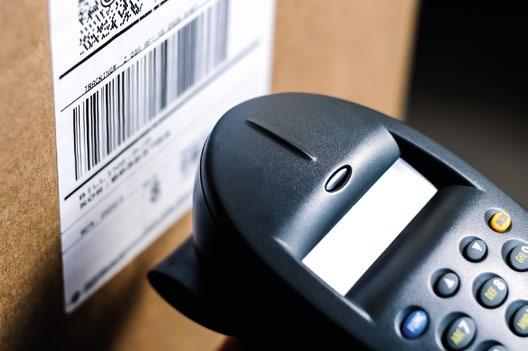

It is not only recycling efforts that benefit from traceability, though. Part of the Packaging and Packaging Waste Directive’s required conditions to define packaging as reusable will include the provision of any relevant information surrounding its traceability. Combining smart technology with reusable solutions can help its enforcers optimize the process by tracking the movements of each pack, charting material flow, and identifying shortcomings in the process.
Closing the loop with technology
Announced last year, PragmatIC Semiconductor’s Technology-enabled Reusable Assets for a Circular Economy (TRACE) platform sought to facilitate this process. Using NFC technology, it aimed to prescribe unique digital identities (UIDs) to each pack, collecting data to evaluate the solution’s environmental
and economic benefits. Within a system like this, reusables can circulate with full visibility and transparency until they are no longer in a suitable condition for further use, at which point they can be located and withdrawn.
Similar systems are currently being piloted with QR technology. Under the umbrella of Starbucks and Hubbub’s Bring It Back Fund, reuse technology company Again is helping Uber Eats trial reusable packaging with a complementary doorstep collection service in central London, while Keep Scotland Beautiful has recruited local businesses around the NC500 route in the Scottish Highlands to trial reusable beverage containers – and these are far from the only projects of their kind. Most remain in the same early stages, however, and their true feasibility is yet to be seen.
The same can be said about a vast majority of digital traceability solutions – they remain in their infancy, currently more theoretical than practical in some areas. The packaging industry is still figuring out how to balance sustainable ideas with thorough security measures while keeping it realistic from an efficiency point of view. Nevertheless, it is heading in the right direction to ensure that its sustainably minded systems are as smooth, effective, and precise as they can be.
13 Packaging Europe
n
Enforcing traceability could be one solution to ensuring that the sustainability credentials of individual packaging designs are accurate.
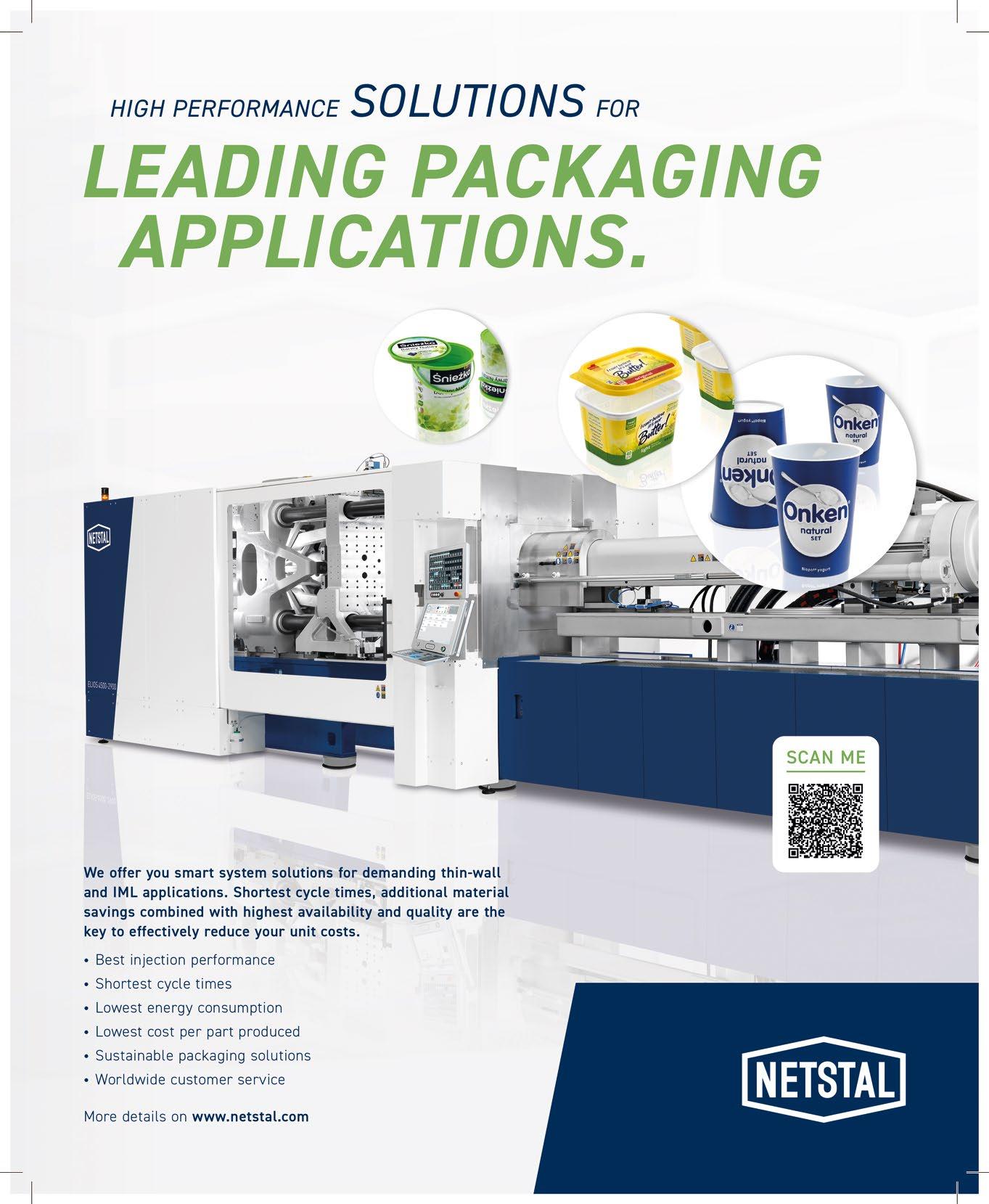
REUSE AND REFILL: FOCUS ON COSMETICS

In November last year, the European Commission announced its planned revisions to the Packaging and Packaging Waste directive including reuse and refill targets, aiming towards a target to reduce 15% of packaging waste by 2040 per capita per member state, proposing that “companies will have to offer a certain percentage of their products to consumers in reusable or refillable packaging” and there will be “some standardization of packaging formats and clear labelling of reusable packaging.”
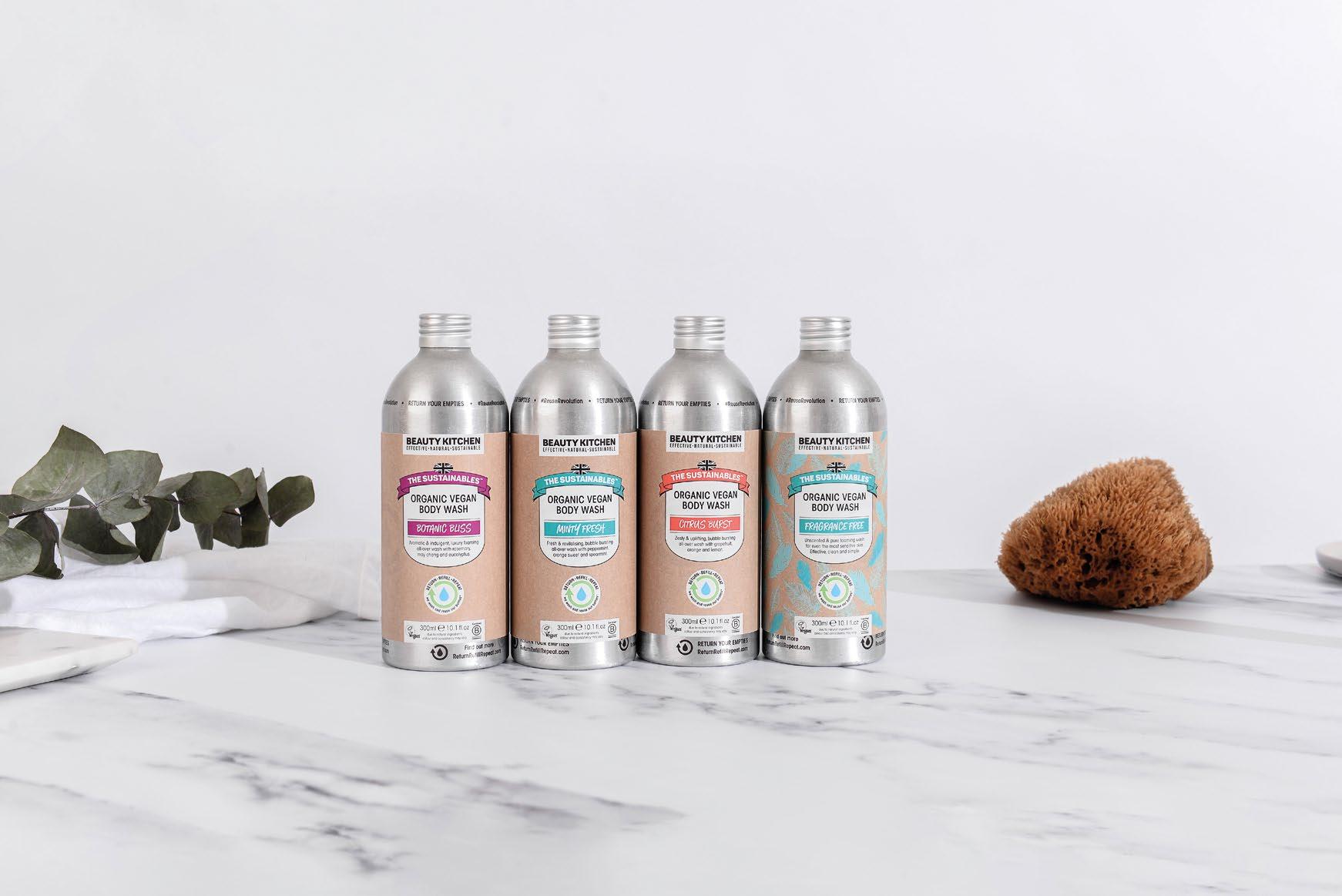
The same month, WWF published a position paper setting out a framework for scaling sustainable reuse systems for plastic packaging, focusing on reducing plastic waste but with a secondary goal of reuse systems which complement strategies such as phasing out singleuse plastics where possible.
The NGO claimed “scaling up European reuse systems by 20% by 2027 would save 1.3 million tonnes of emissions, almost 2.5 billion cubic metres of water, and 10 million tonnes of materials every year”, but cited high entry costs for current reuse solutions as a restriction.
Frances Butler, junior journalist, takes a look at how the cosmetics and personal care sector has reacted and pushed forward developments.
First Steps
Last year, US based cosmetics brand Izzy spoke to us about its refillable mascara solution. The primary packaging for Izzy’s Zero Waste Mascara BLK is a stainless steel tube designed to be cleaned and refilled “over 10,000 times”, contained in a reusable shipper. The consumer can then use the shipper to return the empty mascara tube to the company, where it is cleaned, refilled and sent back to the consumer.
There are also refill options available via either a one-time purchase or subscription. Founder Shannon Goldberg claims the mascara has “a 78% smaller carbon footprint after 25 refills”, with all manufacturing taking place within a 400-mile radius and the water from the cleansing process being reused.
15 Packaging Europe

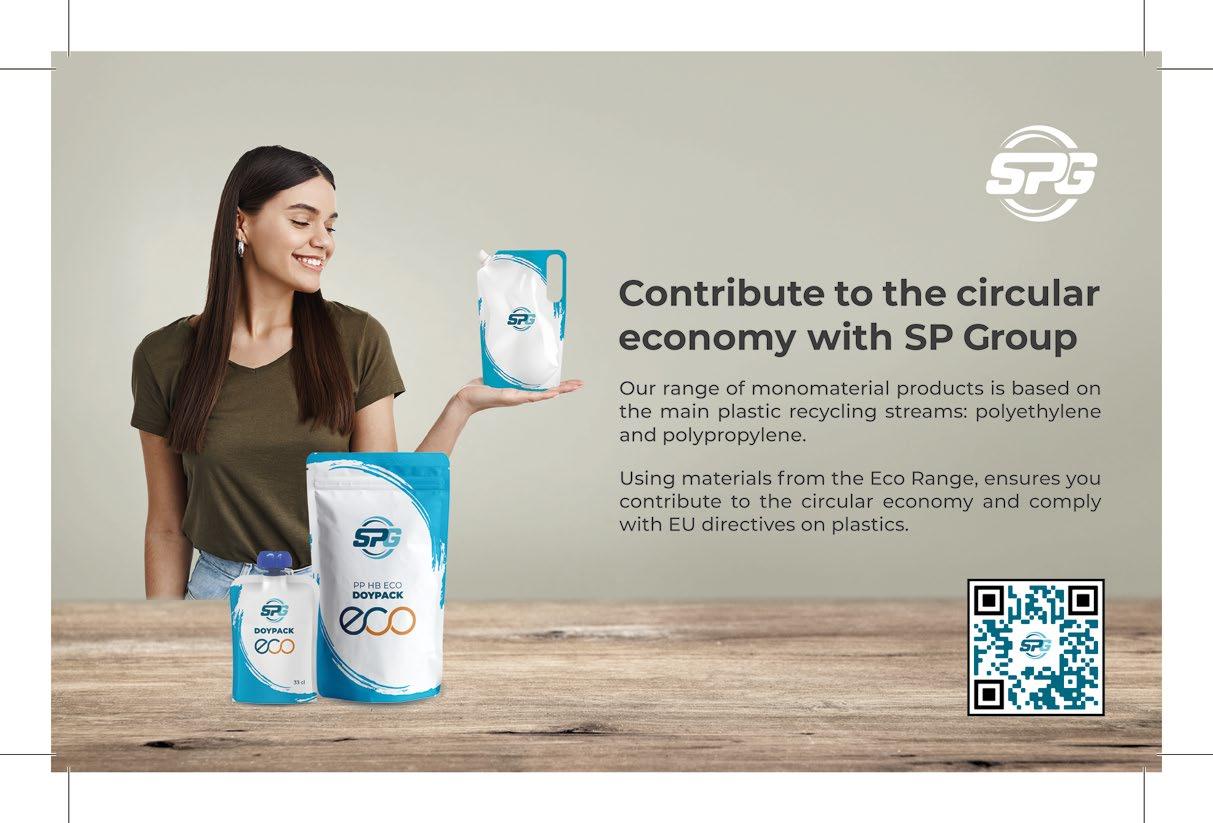
In January this year, Quadpack announced its refillable compact with wooden casing and a twist system to separate the base and lid. The base contains a magnet designed to hold a refillable godet in place and enable separation for recycling, with a recess designed to allow users to extract the godet and replace it with a filled version.
Major deodorant companies have recently begun using reusable and refillable packaging, with Dove launching its first refillable solution in February. The stainless steel case is designed to be refilled until the end of its life, cutting down on the disposal of single-use packaging.
The Body Shop has introduced a refill scheme for its shampoo, conditioner, shower gel and handwash products, stating: “We’ve rolled out refill stations across 720 of our stores globally and we are launching a further 130 in 2023.”
Making reuse work
Another cosmetics company offering refill products is Kao, which states it has 380 refill products, modified according to bottle sizes and viscosity of contents, and has made packaging a key element of its global ESG strategy, aiming to achieve net zero waste for plastic packaging by 2040, and negative waste for plastic packaging by 2050.
One of its refill products is the Raku-raku Eco Pack Refill, used for refilling high viscosity products such as body soap, reportedly reducing CO2 emissions generated throughout the manufacturing, use, and disposal stages “by about 80% compared to rigid containers.”
Asked about the challenges when developing reusable and refillable packaging in the cosmetics industry, Martin Uellner, vice president of research and development at Kao’s Europe Research Laboratories, points out that in Japan, refills have already become an industry standard and that Kao, as well competitors, are selling 80% of their personal care and household products as a refill.
“There have been several challenges, especially creating a truly sustainable refill solution, as currently, refills are often harder to recycle. Refills are still expensive to produce so investment is not yet attractive to many companies, which makes pricing challenging. Consumers want to act sustainably without compromising on quality, user experience or price,” he points out.
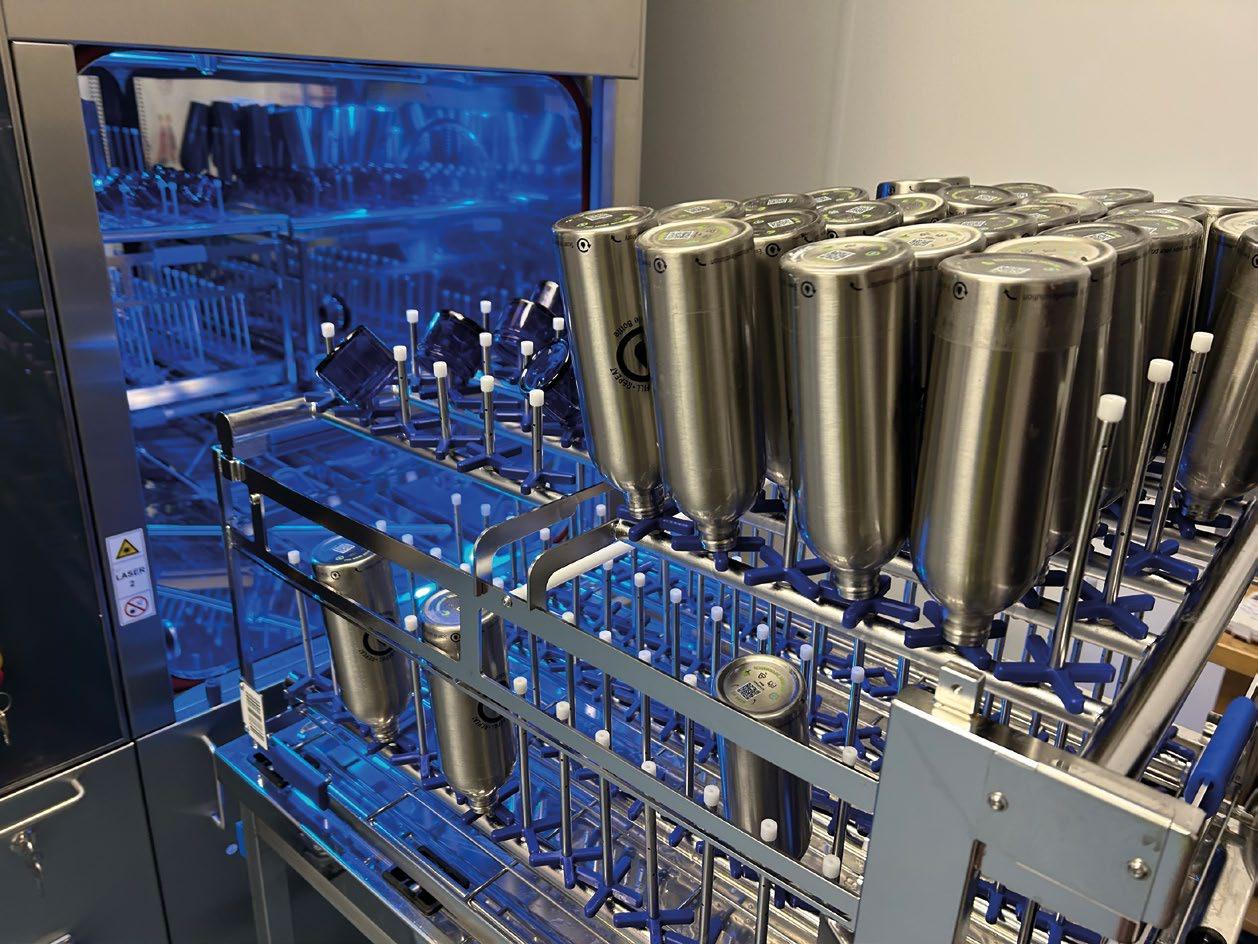
Given these challenges, how can reusable packaging reduce the carbon footprint and use of materials?
Martin Uellner explains that this is hard to calculate as a refill needs to be compared to the individual primary pack it substitutes.
17 Packaging Europe
”
Using refills needs to become a habit but should also be enjoyable. The packaging needs to look attractive, come at an attractive price point, and create a positive user experience.
“Looking at the refill pouches we develop at Kao, on average you save around 70% of plastic versus a standard primary pack.”
Speaking of the carbon footprint, according to OECD, plastics have a significant carbon footprint and contribute 3.4% of global greenhouse gas emissions throughout their lifecycle – so every piece of packaging that is not produced significantly supports efforts to fight global warming.
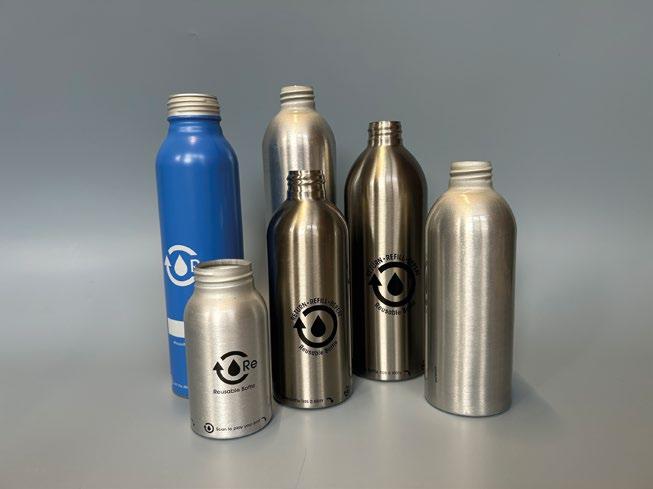
“When looking at materials, it is important to consider the impact of production, transportation and lifecycle. Plastic has a benefit as it is often much lighter and has a lower energy consumption than many of the alternatives,” he adds.
“Therefore, it is a case-by-case decision if plastic, aluminium, glass, or other materials should be used. This depends on the product, the transportation distance, the level of recycling infrastructure in various countries and many other factors.”
Appealing to consumers
Consumers can be hard to please, and Martin Uellner high lights the importance of creating packaging that consumers love to use.
“Refills are not easy to handle. You want packaging that can be completely emptied and does not spill. Our research and development team in Japan has consistently improved the refill packs and has created a unique nozzle, enabling an easy-tohandle, clean and efficient refill process for the consumer. Kao is holding a patent for this technology.”
He explains that one specific challenge was to change the typical pouch shape into a very compact form to reduce head space and have a stable base.
“This has been achieved by changing the pouch from a classic triangle shape to a cylindric shape with a flat top sheet and a special flat spout construction.”
The company has plans to scale up and introduce more refill solutions into its portfolio, especially in the salon and the luxury sector.
“Refills offer a big benefit to salon owners as they produce less waste and are easy to store. For our British boutique brand Molton Brown we have just launched our Infinite Refill bottle, an aluminium bottle that can be refilled with a range of our bath and body products.”

Martin Uellner believes that from an ESG point of view, refills have a clear advantage and are an important building block to reducing plastic packaging, but reiterates that companies need to win consumers’ hearts.
“Using refills needs to become a habit but should also be enjoyable. The packaging needs to look attractive, come at an attractive price point, and create a positive user experience. This has been the success model in Japan and I am convinced we can be successful with refill packaging in other markets as well. But it needs all players in the cosmetics industry to join forces. The industry and consumers need to drive the change together.”
Looking towards the future, he points out that to address the aim of zero waste, we need to investigate various options: “Compacting products so they need less packaging, waterless solutions like soap bars that can be packed in paper instead of plastic – or turning a refill pack into the primary pack.”
Breaking the status-quo
Making progressive changes to current systems, such as creating a “universal, professionally-refillable” reusable packaging platform is the brainchild of Re, a reusable packaging platform created by Jo and Stuart Chidley, the founders of sustainable beauty brand Beauty Kitchen. Re leases packaging to brands, provides standardized reusable packaging made from stainless steel, aluminium and glass, and is aiming to coordinate retailer engagement and implementation of a nationwide network for return points, washing and reuse.
Jo Chidley highlights that the systemic changes required to shift from a take-make-waste system that has been “perfectly designed to make profit and waste over the last 70 years” can only be achieved with collaboration.
“The barriers that need to be overcome include moving together to standardized smart reusable packaging-as-a-service and shared investment in a reuse platform that is consumer centric, including convenient return locations, consumer rewards, reverse logistics and washing facilities. From our work to date the innovation required is not technically challenging. In our experience businesses are willing to collaborate on systemic change and the momentum is building.”
18 Packaging Europe
”If reusable packaging is developed to only be reusable for one product, brand or organisation it is massively less likely to be reused. If each standardised packaging type could be reused on 100 different products, […] reuse could be guaranteed.
Reusable and refillable packaging has many sustainability benefits, as she points out.
“Ultimately reuse keeps our planet’s limited resources flowing in continuous cycles and at scale, which generates the consumer behaviour change and return rate.”
She concedes that packaging designed for durability and reuse will often have higher carbon emissions for its first use, but highlights the fact that sustainability should be measured over its lifetime, using future input values and considering every other element of the LCA including waste and impacts on biodiversity.

“With the right standardization and system design, with local returns, washing and reuse, reusable and refillable packaging should deliver lower emissions and waste.”
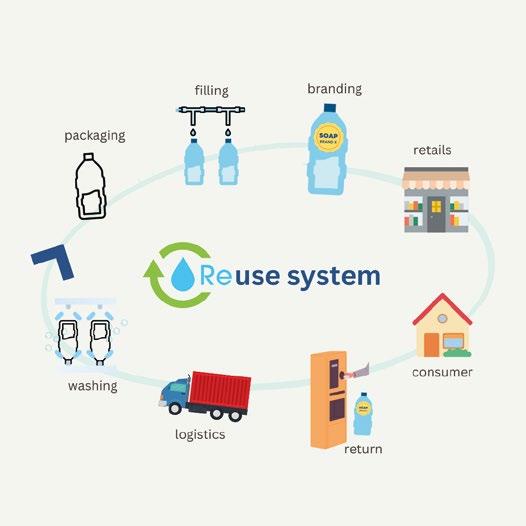
Jo Chidley describes breaking the status-quo of a well-designed and profitable single-use system as the biggest challenge to overcome.
“Whilst many individuals and some businesses believe that reuse is the correct long-term answer, short-term financial pressures make collaboration and shared investment without legislation challenging. Systemic change is hard, it requires real innovation, collaboration and long-term commitment.”
Standardization is key
Re provides standardized reusable packaging and leases packaging to brands. This can make a difference, as she points out.
“If reusable packaging is developed to only be reusable for one product, brand or organization it is massively less likely to be reused. If each standardized packaging type could be reused on 100 different products filled in many different factories in many different locations reuse could be guaranteed. The
packaging-as-a-service means the item can be leased for a very similar cost to a standard bottle. The lease fee includes the reverse logistics and washing cost, removing the complexity and cost from the user.”
Re is working with a range of brands, retailers and global packaging suppliers to build a universal, professionally-refillable, reusable packaging platform, starting in the UK to build a globally scalable model, and Jo Chidley concludes with a call to action:
“We are working with WRAP and the UK Plastic Packaging Pact on a series of workshops to engage as many collaborators as possible ahead of a shared investment in implementing the system. You can expect to see it in action in some major retailers with major brands soon and we are calling
It’s fair to say that 2023 – with its geopolitical issues, inflationary pressures, and lingering COVIDrelated complications – wasn’t always smooth sailing for the packaging industry. One area that was particularly hard at work in terms of keeping up with consumer expectations (which, inevitably, remained largely unchanged) was weighing and inspection.
In this article we’ll look back at some of the innovations in this field that we covered on our website in 2022, whilst also looking at some of the innovations that were demonstrated at interpack 2023.

LOOKING TO THE FUTURE (AND THE PAST) OF WEIGHING AND INSPECTION
What did we see in 2022?
SICK unveiled two new solutions in this category in 2022 – its Smart Box Detection system and Roller Sensor Bar. The former is a part of the deTec4 Safety Light Curtain, and aims to ensure operator safety and a continual and efficient output on packaging lines. It uses intelligent pattern recognition to detect cuboid objects and differentiate them from human operators, which is said to prevent unnecessary interruptions and stoppages at the in- and outfeeds of packaging machinery.
Meanwhile, the roller sensor bar has been designed for quick and easy installation, high sensing performance, and preventing conveyor jams that can cause unplanned downtime in packaging, parcel sorting, and logistics
hubs. Its job is to detect the leading edges of varied, flat or irregularly shaped packages on conveyors.
It also appears as if the benefits of deep learning are starting to be felt in the detection sector – with Cognex introducing a vision system that automates error detection in minutes, without PC or programming skills.
Using an array of tools, deep learning can locate and count complex objects or features, detect anomalies, and classify said objects or even entire scenes. It can also recognize and verify alphanumeric characters using a pre-trained font library.
On a similar theme, Pellenc ST’s latest instalment of its Xpert technology combines a dual-energy transmission X-ray with machine learning, a form
20 Packaging Europe
of artificial intelligence said to learn and remember data to improve the efficiency of metal and e-scrap waste sorting processes.
Meanwhile, on slightly more familiar ground, Ishida unveiled an X-ray inspection system that combines sensor and image processing technology to detect small and low-density foreign bodies inside a pack.
The IX-PD, combined with Ishida’s existing Genetic Algorithm (GA) and Dual Energy technologies, is designed to produce a clear, high-resolution image when detecting low-density items and foreign bodies, including stainless steel wires and bones in fish fillets. It is claimed that the X-ray process is still effective for products that overlap or stand upright within a pack.
Wipotek’s All-in-One Inspection Unit represents a number of different solutions in one machine, combining X-ray for foreign objects detection and precision checkweighing in a single vision system that can also verify label placement, barcode legitimacy, film detection, and validation of expiration.

What was on show at interpack 2023?
One of the centrepieces of Ishida’s offering was CCW-AS, the company’s 11th generation of multihead weighers. Ishida also demonstrated the IX-PD – an X-ray inspection system that incorporates new sensor and image processing technology in a bid to achieve the highest level of detection sensitivity.
Scanware also made an appearance – with a particular focus on an AIenabled inspection solution named ‘Quality Intelligence’. QI follows a modular
21 Packaging Europe
Using an array of tools, deep learning can locate and count complex objects or features, detect anomalies, and classify said objects or even entire scenes. It can also recognize and verify alphanumeric characters using a pre-trained font library.
build, meaning administrative and inspection tasks are handled in separate areas. The data base at the centre evaluates teach-in images, creates inspection parameters and eliminates potential for human error caused when manually inserting parameters.

The highlight on the Minebea Intec exhibition stand was the new metal detector Mitus with MiWave technology. This solution reportedly enables extremely precise detection of foreign objects, even with large product effects.
MiWave is used to modulate the transmission signal for several frequencies, then separate and evaluate them individually using an intelligent algorithm. As a result of this division into several signals, the products can be symbolically inspected from several perspectives. This increased information content apparently means that high search sensitivities can be achieved despite large product effects. In addition, Minebea reports that the technology is less susceptible to fluctuations such as temperature changes or thawing processes.
NSY, Marchesini’s brand-new no-contact monobloc machine for the high-speed automatic inspection of syringes, also made an appearance at interpack 2023.
The monobloc consists of a unit which performs robotized picking of the syringes from tubs/nests and feeds them into the inspection phase in a
single row with no contact between syringes or with metal parts. The heart of this solution is inspection itself, which can reportedly achieve speeds of up to 36,000 syringes/hour.
This part of the machine can contain up to ten inspection stations to inspect every zone of the syringe: flange, stopper, particle detection, filling level, needle shield, defects in the glass walls and integrity inspection using HVLD (High Voltage Leak Detection) technology.
Meanwhile, PFM demonstrated the multi-head weigher MBP 12 C4 in the fragile products industry. The solution has been designed to minimize impact and therefore eliminate the risk of product breakage during weighing phases.
The strength of the 12 C4 multi-head weigher’s design concept is to reduce the product’s falling height as much as possible and thus the impact against rigid surfaces.
It is characterized by 12 weighing buckets fed directly from the vibrating channels, excluding the pre-dosing buckets. Furthermore, the central vibrating plate, used for distributing the product on the radial channels, has a flat horizontal shape: a feature that improves the product’s distribution on the channels and minimizes the product’s falling height coming from the loading system, which is only 80 mm. n
22 Packaging Europe
HOW THIS ISSUE WAS
The job of producing each issue of a magazine requires a real balancing act: deadlines to be met, sponsors to close, graphics to approve, and of course – printing it to life. And everything always needs to be faster, cheaper, and of the highest quality. The printing process we chose for this issue is with the Landa S10P Nanographic Printing® Press, which answers all the above.
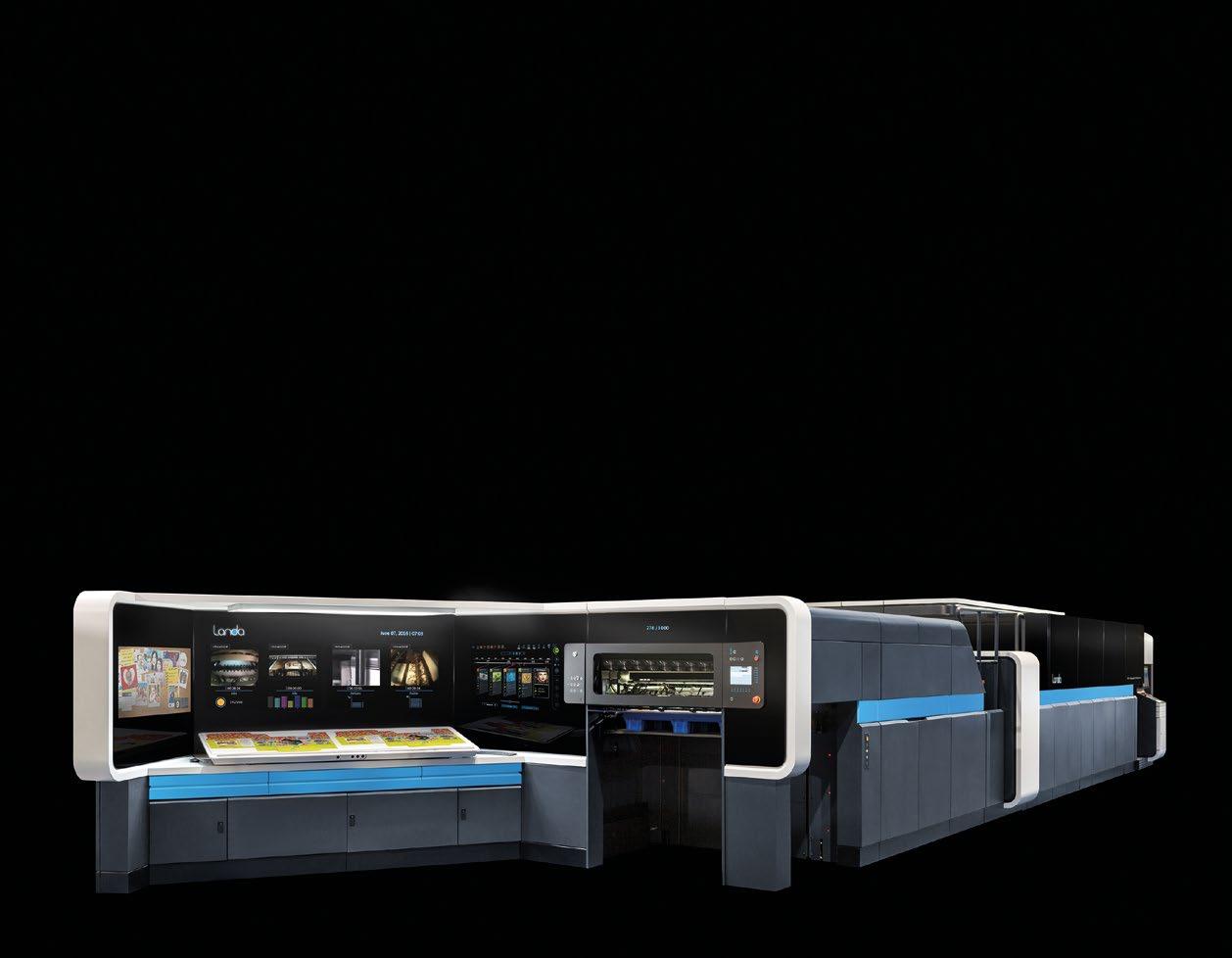
First, there is the question of speed. A print run of this size would normally require us to print on traditional offset presses: 16 pages per sheet, which then need to be collated to be bound properly. This without mentioning the normal offset make-ready process, which is both time-consuming and wasteful. We were pleased to learn that Nanographic Printing® avoids these common challenges. Pages are printed pre-collated, no make-ready needed, and the issue can be bound in two steps, greatly increasing efficiency.
Next, we look at costs. There are a lot of things that go into the cost of printing a magazine like this, but one of the prominent factors that spring to mind is that Nanographic printing doesn’t use plates while still being able to produce a run of the length required. Aluminum is, after all, not getting cheaper (and is one of the most environmentally hazardous metals to produce). The inks are water-based, too, which contributes to a lower carbon footprint.
Consistency naturally also plays into costs. Colours should be the same whether you’ve got an issue from the start, middle or end of a batch, and any deviation costs time and money to fix. No plate changes and a single set-up for the entire run means we were able to rise to the consistency challenge beautifully.
And lastly, there is the topic of quality. Quality can mean different things for different uses. Some packaging requires strict brand requirements that dictate how logos and colours should come out. Certain verticals, which you will read

about shortly, have strict regulations that require a press of a uniquely high calibre. For a magazine like this, it’s the vibrancy of the colours and the sharpness of text and image that matters to the readers. The Landa presses clear the bar on all accounts. The ultra-small drops create far less colour bleeding, and the wide colour gamut produced as many different rich colours as we needed.
All three of these aspects – speed, costs, quality - could be summed up in one word: sustainability. Not only in the environmental sense, though the reduction in waste certainly helps in that aspect, but in the sense of being able to reduce our footprint not just for this issue, but for the next one as well, and the one after that. And all the while not compromising on the standards of quality that keep us in business.
Being able to maintain a consistent standard, without increasing costs or resorting to corner-cutting practices that often end up hurting the environment, is a tremendous advantage we were happy to be able to showcase in this issue.
23 Packaging Europe
We have gathered some of Landa’s customers to tell us their impressions of using their Landa Presses and how they added value for their own customers and their brands:
BLUETREE GROUP

Bluetree Group, which printed this issue of Packaging Europe on its Landa S10P Nanographic Printing® Press at its South Yorkshire site, is the UK’s largest online commercial printer. It operates several brands, among which are: Instantprint.co.uk, which offers direct to consumer print catering mostly to SMBs; Route 1 Print, the UK’s largest online
trade printer; and Kingsbury Press, a preeminent luxury books printer. All three brands take advantage of the group’s Landa Press.
“Our focus is on high-quality production and ensuring we make innovative use of technology wherever possible to increase efficiencies for customers,” says Phil Tasker, head of the Route 1 Print brand. “The opportunity for us with Landa lies in achieving excellent quality and high resolution on the print with simultaneous cost savings. It ties directly into our commitment to empowering and simplifying the lives of our print buyers.”
Tasker names Landa’s sheet size, flexibility and ability to handle variable data as additional advantages. “What Landa allows us to do is bridge the gap between digital and offset printers as we’re finding that medium runs are becoming more and more popular as budgets get stretched with customers.”
Tasker mentions that the Landa has already opened up new avenues for Bluetree Group into sectors that require advanced levels of scope and expertise. “It’s looking particularly exciting when it comes to producing large scale floorplans for high end American property developments which can demand up to 100 versions in an A1 format. Landa is allowing us to actively problem solve on projects like this that have an extra element of complexity.”

24 Packaging Europe
“It’s looking particularly exciting when it comes to producing large scale floorplans for high end American property developments which can demand up to 100 versions in an A1 format. Landa is allowing us to actively problem solve on projects like this that have an extra element of complexity.”
MAYR-MELNHOF (MM) PACKAGING PHARMA & HEALTHCARE

Mayr-Melnhof Packaging is a leading international producer of folding cartons and is organized in four different business units. Among others, the MM Packaging Pharma & Healthcare business unit is fully dedicated to the manufacturing of secondary packaging for this industry, providing folding boxes, leaflets, labels and booklets from 28 sites across the world.
Its Landa S10 Nanographic Printing® Press is located at its Bradford site, which produces cartons and leaflets for the pharmaceutical industry.

“For us it’s important to have the Landa Press for its larger sheet size and flexibility,” says Marga Romo, Head of Marketing at Pharma&HC business unit. “We see how runs are getting shorter as a trend in the pharma industry. That’s why we looked towards a digital solution and specifically the Landa.”
The pharma industry has strict quality and colour requirements, which the Landa was extensively tested for. “Our customers don’t specify which technology they want their product printed on,” says Romo. “We make that decision depending on factors such as batch size with absolute consist-
BLUEPRINT AG
INits 27 years of existence, BluePrint has grown into one of the biggest printers in Munich. The Landa S10P Nanographic Printing® Press is its latest press, starting production one year ago.

BluePrint does much of its business with both the automobile industry and the pharmaceuticals industry. Many of the jobs, especially for the Swiss market, requires having multiple versions of the same product in
ency in quality regardless of the technology used. Some therapies, such as oncology, have small batches. We can produce these in the Landa and the customer knows their quality is guaranteed.”
Romo also highlights the decrease in waste associated with the Landa. “During the cardboard shortage in COVID era, digital printing enabled us to generate a greater number of jobs while using less material, ensuring we could meet our customers’ needs during a challenging period.”
different languages. “We may receive a request for a pharma customer that wants the same run with 80% in German, 10% French, and 10% Italian,” says Gerhard Meier, CEO of BluePrint AG. “We must have consistency across all languages. That’s where we rely on Landa’s flexibility. We can send the entire batch as one job, without needing to switch plates from one language to another, and the costs are much lower than they would be if we were to print the whole thing on a digital press. Coupled with runs getting shorter, we found that we can print most of our jobs through the Landa at a good price point.”
Blueprint AG considers itself unique for its adoption of new technologies. It is currently the only printer in Germany that prints in seven colours. “One of our clients is a bookazine called ‘Rize’ which we wanted to ensure printed in the highest quality with no compromise. Printing on the Landa in seven colours resulted in such intensive colours and sharpness, we’ve had some of the readers of the bookazine come to us as customers wanting to get the same level of quality for themselves.”
25 Packaging Europe
“We must have consistency across all languages. That’s where we rely on Landa’s flexibility. We can send the entire batch as one job, without needing to switch plates from one language to another, and the costs are much lower than they would be if we were to print the whole thing on a digital press.”
“For us it’s important to have the Landa Press for its larger sheet size and flexibility.”
SOUTHERN CHAMPION TRAY (SCT)
Founded in 1927 in Tennessee, Southern Champion Tray specializes in paperboard packaging, supplying packaging for products from food service to retail, nutraceuticals, beauty, pet, and more. Their Landa S10 Nanographic Printing® Press is located at their Mansfield site.
“Our business model is based on rapid response,” says Brad Haralson, General Manager at Southern Champion Tray. “We offer a quick turn to market application, running at about two to three weeks from start to finish. The Landa was a great fit for us because it allowed us to get a little bit more specialty in our applications while also giving our customers the prospect of doing smaller volume runs with more customization without sacrificing speed.”
A particular case that exemplifies the value that Landa brings to SCT’s customers comes from a brand that produces energy bars. “Each differ-
GROUPE PRENANT


Groupe Prenant is a French family-owned printing company with three factories surrounding Paris. Its Landa S10P Nanographic Printing® Press has been with the company for four years.
“Groupe Prenant is able to have a response on quite any subject with different teams with different plans,” says Philippe Vanheste, Deputy General Director at Groupe Prenant. “From a million copies of a simple document to a high value document with small quantities and personalized application. The latter is especially suitable for the Landa, which can handle variable data in ways that classical print simply cannot.”
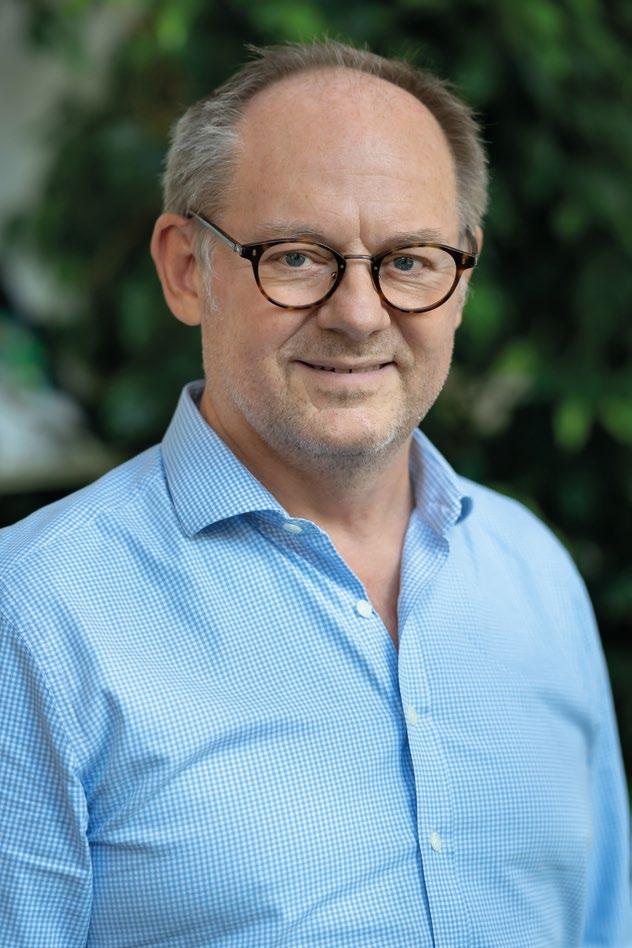
A stand-out case for the Landa came in the form of a puzzle job, which involved printing both the puzzle and its packaging. “The most expensive stage for a puzzle is cutting the forms, but after that, it’s printing with classical offset. Offset print is not expensive with a large quantity, but for a puzzle company it’s very important to have as many versions at the same time, with the unit cost as low as possible. Changing from offset to Landa we were able to make that marketing strategy work. It essentially opened a new market for Groupe Prenant.”
The Landa color gamut also played a part in that case. “Originally, the customer asked for four colour plus an additional spot color. We were able to show them that printing in seven colours we have the ability to reach the same quality as an offset printer with the added pantone® tone or better.” n
ent flavour of bars means a plate change on an offset press,” states Tara Duckett, Sales Manager at SCT Mansfield. “With the Landa, we were able to avoid the eight hours of make-ready that would be necessary for this type of job. Another customer, a seafood company, has 14 different versions in their product line. It’s so much easier to print a job like this on the Landa, without the common worries associated with gang or combo running.
“What’s more, the Landa’s colour gamut allowed us to produce the type of vibrant colours that help the customer’s product stand out. Us being able to print three or even more spot colours without increasing the price was tremendous for them.”
“With the Landa, we were able to avoid the eight hours of make-ready that would be necessary for this type of job. Another customer, a seafood company, has 14 different versions in their product line. It’s so much easier to print a job like this on the Landa.”

Packaging Europe 26
“Changing from offset to Landa we were able to make that marketing strategy work. It essentially opened a new market for Groupe Prenant.”
FOCUS ON PACKAGING PRINT: LOOKING AHEAD TO TOUCHPOINT PACKAGING AT DRUPA 2024
The world of packaging is dynamic and fast-paced, and packaging printing is no exception. A year ahead of drupa 2024, Elisabeth Skoda takes a closer look at the touchpoint packaging event series and explores industry megatrends.
Packaging Europe is excited to support touchpoint packaging as a content and media partner. In its third iteration, the event series, taking place from May 28th to June 7th, will offer drupa visitors a dynamic platform which will zoom in on a range of topics around packaging printing and will focus on environmental, technological, economic, social and legal aspects. The event will pinpoint challenges, present innovative solutions and showcase added value, impulses and growth potential for packaging solutions in a constantly changing world.
Visitors, in particular brand owners, will be able to attend presentations that feature best practice examples and innovative packaging design, and that give an overview of the latest developments in design and production and gain useful insights. There will be no charge for the event.
Packaging experts from across the value chain, from material sourcing to production and workflow to converting and retail will take part as partners or active participants. Participants include major drupa exhibitors such as esko, Koenig & Bauer, Heidelberg, HP, Zecher, hubergroup, KURZ, manroland Goss and Saueressig.
drupa continues its successful partnership with the European brand and packaging design agency edpa, which will be responsible for the concept and the running of the event. Marketing intelligence agency Mintel will support the event with specialist knowledge.
Furthermore, all members of the packaging printing value chain are invited to become exhibiting partners, whether it’s brands, material suppliers, convert ers or embellishment experts. Find out more at www.drupa.com.
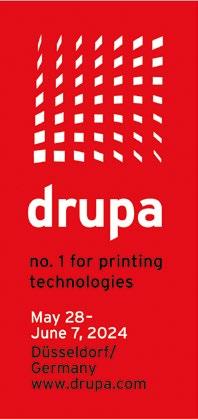
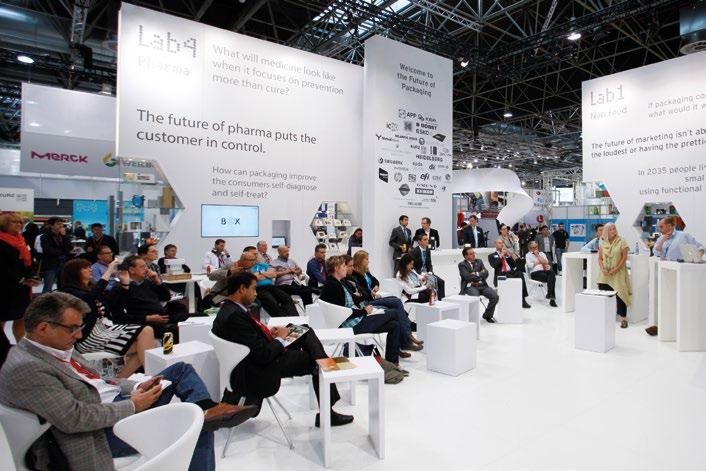
Ahead of the event, we asked key stakeholders about what visitors can expect from the touchpoint packaging event and what key industry trends they have observed.
What can visitors expect to see at touchpoint packaging?
epda Vice-President Uwe Melichar: We want to discuss topics ‘Beyond machines and materials’. It’s important to involve all stakeholders of the value chain and to take a holistic look at things, including the design perspective, we believe. We will focus on use case scenarios and inspire with future-oriented product and packaging solutions.
What are the key trends that will be addressed at the event?
Claudia Josephs, epda General Manager: Our objective is to show visitors how new technologies in print and packaging can meet the needs of the end-consumer and inspire brand owners when developing new products and packaging. For that purpose, we have defined five key topical areas reflecting the main overall trends. These topics will be leading exhibition contents as well as the all-day conference programme: Neo-ecology, glocalization, taxes and regulations, connectivity and the consumer’s mind and behaviour.
What
major trends
and developments
observed in the packaging industry since the last drupa?
have you
Dr Andreas Pleßke, Vorstandssprecher Koenig & Bauer: Today, packaging has considerably more functionality. It’s not only about protection, transport, shelf life or the marketing message at the point of sale. The next phase has started, and traceability, authenticity and augmented reality solutions that offer added value to customers are in high demand. Packaging is becoming interactive. On top of that, brand owners and their customers demand sustainable packaging.
Christian Menegon, Business Development Manager Industrial Products at HP: A very visible newcomer amongst the trends is sustainability. This word is too generic to define measurable and comparable targets and is therefore hard to quantify. For instance, an ink manufacturer will use fewer
27 Packaging Europe
motors; a brand owner will reduce its inventory and therefore produce less waste; at home, I have replaced all halogen lamps at home with LEDs, etc… All of these actions are important but which one counts more than the others? While comparison is not necessarily possible and maybe even not needed, it is good that industry players are innovating to save the planet; this leads to the implementation of changes, process innovations, workflow improvements, etc. It is fair to say that cooperation between actors of the value chain will bring even better results. In the past any improvement was geared more towards better specs, performance and cost reduction; nowadays the new eco-system brings different targets. Efficiency, waste reduction and circularity can be seen as the ‘headlines’ for whatever internal development plan a given company acts on, with many diverse sub-levels.
Jan De Roeck, Esko Director of Marketing, Industry Relations & Strategy: Given that 2020 saw the need for drupa to go virtual due to the global pandemic, the last physical event was in 2016 – seven years ago, which really is an eternity in terms of technological evolution. With that in mind, the main trends I have observed since are the ongoing acceleration of digital transformation and the ever-growing impact of environmental sustainability. Taking a bit of a higher vantage point to look at these two megatrends, I really believe the end-user of packaging, i.e. the consumer, is impacting both of these megatrends. The macro-economic and societal megatrends that are happening around us – which include supply chain issues, inflation, a pandemic, online shopping, consumer trends, the war in Ukraine, political polarization, and many more – have a profound impact on how and what consumers buy. As a consequence, brands and retailers accelerate the speed at which they respond to these changing consumer needs.
of consumers. The packaging and label supply chain needs to follow. Pressure on lead times is the most frequently heard business challenge, with quality now being the expected absolute minimum, table stakes if you will, and cost pressure never having left the scene. Given that, there is only one way forward for packaging and label converters: to seek operational excellence and continuous elimination of waste and cost out of the production process. And the environmental sustainability debate fundamentally also starts with the consumer. A profound desire to safeguard our planet for generations to come is an underlying societal trend with a profound impact on packaging. Reduction, recycling and re-use of packaging may well be a substrate-centric discussion in the first place, but every step in the process from concept to shelf can contribute to waste reduction. This way sustainability and operational efficiency are tightly connected. n
Find out more about the event at https://www.drupa.com/


28 Packaging Europe
UNPACKING INTERPACK A LOOK BACK AT THE 2023 EVENT

In May, interpack, the fixture in the packaging landscape returned as an in-person event to Düsseldorf in Germany for the first time since 2017. With visitors from 155 countries and a total of 2,807 exhibitors, the trade show had a massive scale, covering 18 trade fair halls. We look back on a busy and successful event.
interpack 2023 was organized into seven main areas according to enduse: food, beverages, confectionery and baked goods, pharmaceutical products, cosmetics, non-food and industrial goods. Each of these hosted exhibitors from every part of the value chain, from packaging material and packaging producers to processing machinery, smart packaging technologies, labelling and finishing, and everything else that goes into bringing a pack from concept to the end of its life.
The Packaging Europe team was in the middle of it all with our own stand which we used as a base and to promote our Sustainable Packaging Summit in Amsterdam in November – it was great to connect with so many of you, the response was overwhelming. In addition, we visited stands, attended press conferences and reported on the latest developments and
innovations launched at the event – of which there were many! We also successfully launched our ‘60 seconds with…’ video interview series, which proved very popular. Last but not least, our brand director Tim Sykes hosted three of Taghleef’s Ti Talks Live sessions – high-level discussions with industry experts from the full value chain, as well as Kloeckner Pentaplast’s panel discussion on what is preventing the industry from accelerating a circular future for plastic packaging.
Given current market developments and the challenges and opportunities faced by the industry, interpack offered a valuable space to exchange ideas. Rapid transformation is happening, and the need to automate, the will to act sustainably and changed consumption habits are all expressions of transformation.
29 Packaging Europe
Attracting plenty of attention were specials such as the interpack Startup Zone, the joint stand Co-Packing, several award ceremonies spotlight ing exciting packaging innovations, the ‘SAVE FOOD Highlight-Route’ with new approaches to fighting global food loss and waste and last but not least, the ‘Women in Packaging’. We at Packaging Europe greatly enjoyed the event – it was inspiring to hear experiences of successful women in the packaging industry and to network.
Spotlight on packaging innovation
interpack’s strategic orientation towards the four Hot Topics: Circular Economy, Resource Management, Digital Technologies and Product Safety found concrete expression in numerous innovations – far too many for the scope of this article, but let’s shine a spotlight on just a few.


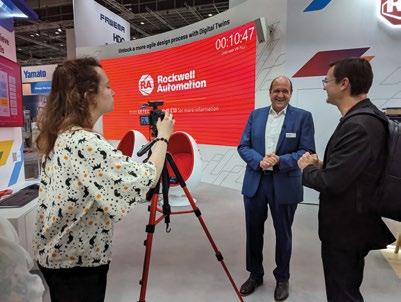
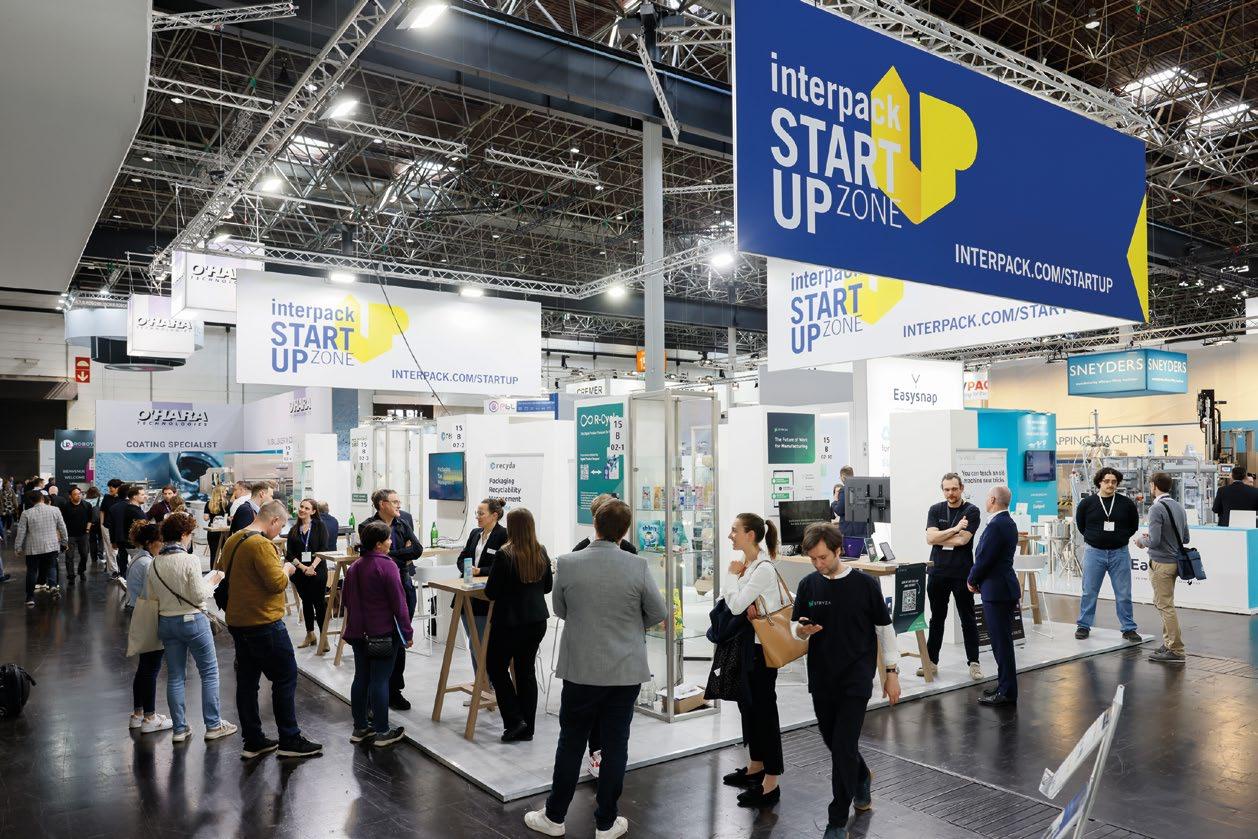
In anticipation of the EU’s upcoming Sustainable Products Initiative, a drive-based energy monitoring software from Baumüller is designed to help companies calculate and provide evidence of their energy usage at various points in the supply chain. Meanwhile, Syntegon is aiming for a 30% reduction in energy consumption with the ‘modern electronics concept’ of its LFS filling solution for sauce, dips, and other liquid or viscous deli foods.
Material optimization is another progress point. While the LFS filler is compatible with both paper and polypropylene, ROTZINGER Group’s WRF Flex slab former widens a slab and compresses it to the finished width –reducing the density at the edge of edible bars to shrink or even eliminate packaging trims in a waste reduction effort.
Heidelberger Druckmaschinen AG unveiled an innovation for the segment of high-volume folding carton printing, which it describes as a strong growth
30 Packaging Europe
reduces the total cost of ownership in industrial packaging production.
Blue Ocean Closures, Stora Enso, and AISA launched what is claimed to be the first paperboard tube with a fibre-based closure, reportedly consisting of over 85% fibres. All the components of the new tube are designed for recycling. The fibre-based screw cap – developed by Blue Ocean Closures
to increase resource efficiency, thus utilizing fewer materials than conventional multi-layered and complex materials.

Gauging the state of the industry
Düsseldorf’s interpack has always provided a triennial snapshot of the
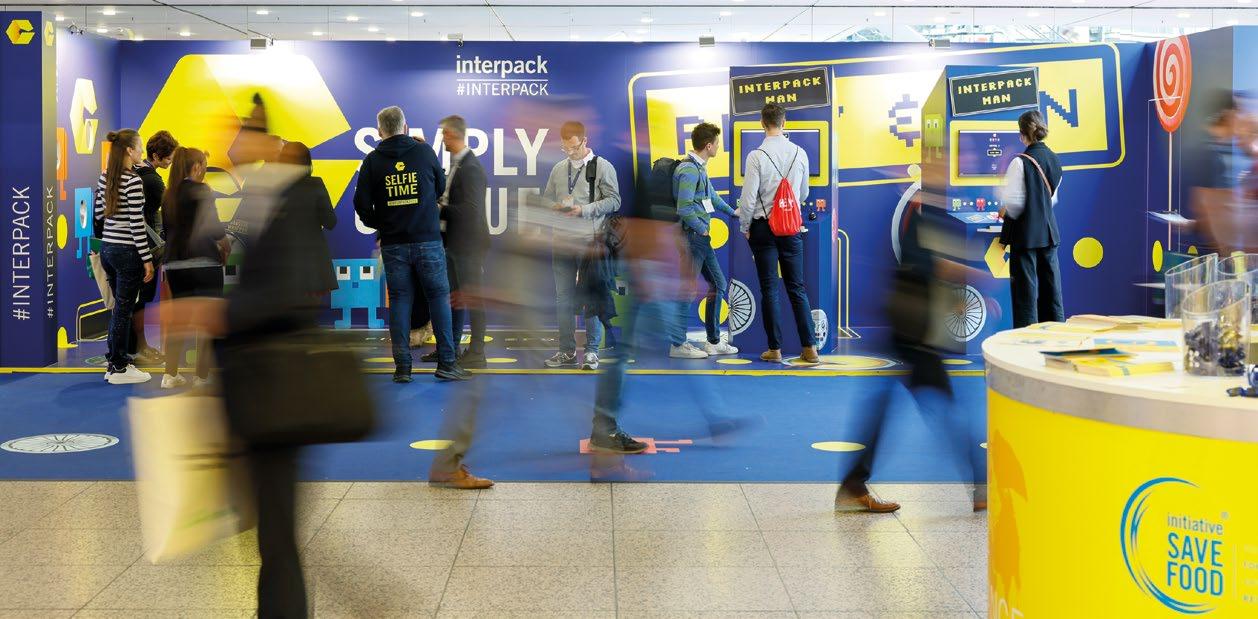
functionality, from flexible barrier papers to moulded fibres, with a view to realizing opportunities to offer the renewable/recyclable substrates in applications dominated by fossil-based plastics. I recommend watching the products being brought to market by key players such as Stora Enso and Metsä, as well as disruptive newcomers such as Delfort.”
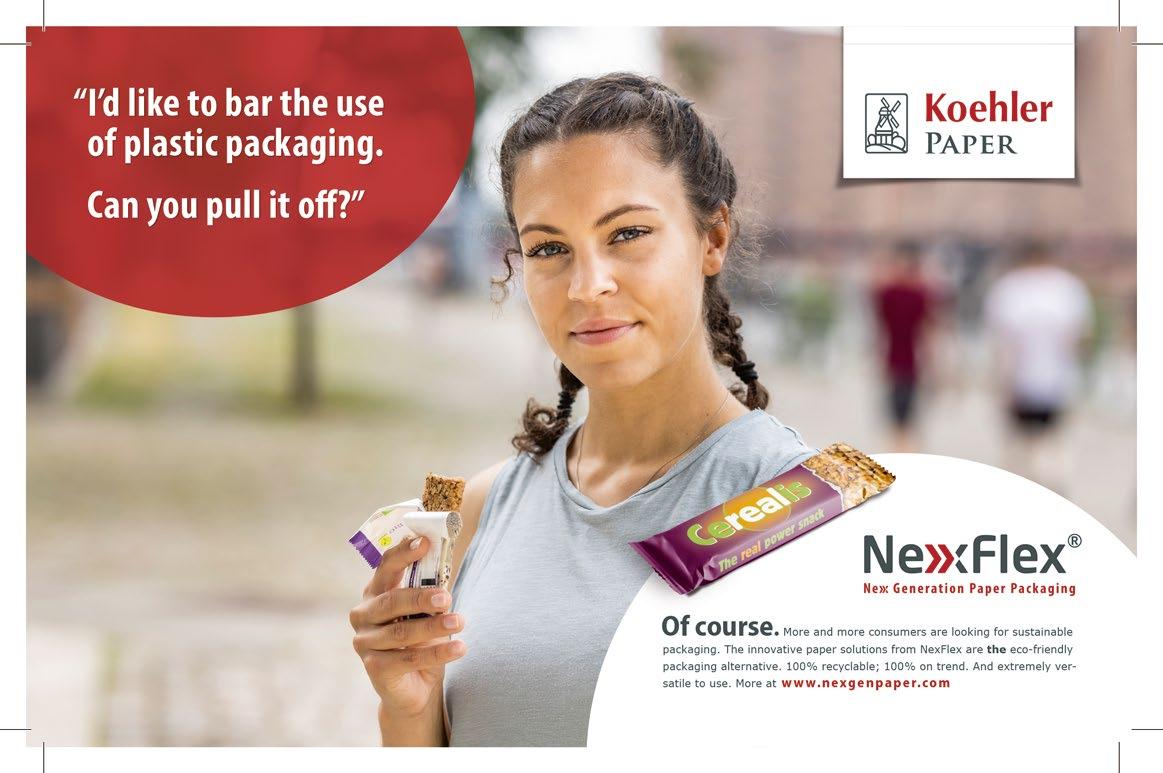
He notes that meanwhile, in plastics there was less breakthrough innovation on show, for the reason that much of the breakthrough innovation around monomaterials and design for a circular economy has already taken place.
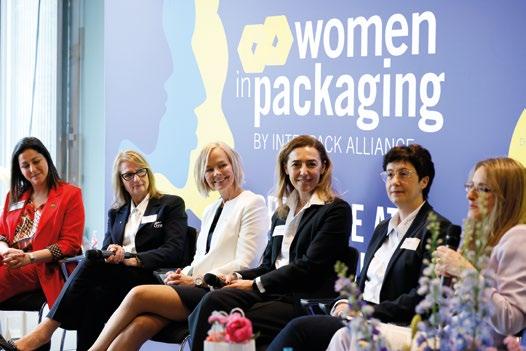
“At least three times in Düsseldorf I heard the same point being made about circular plastics: ‘We know what we need to do: now it’s all about realizing it.’ For plastic packaging, the challenge is no longer primarily technological, but one of aligning stakeholders around harmonized strategy and investment. As such, some of the most inspiring conversations I had at interpack involved start-ups (such as Resycure and Recyda) who are bringing smart information-based approaches to removing friction from the circular economy.”
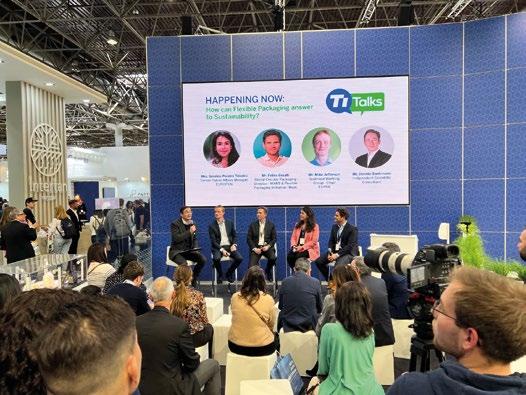
32 Packaging Europe
n
WHAT DOES THE DIGITAL TRANSFORMATION MEAN TO PACKAGING MANUFACTURING?
Technologies such as cloud-based manufacturing, AI, and the Internet of Things (IoT) can all combine to deliver solutions, optimize production, empower the workforce, and drive sustainability. By transforming operations in manufacturing to more streamlined processes, digital solutions are shifting the dynamic of the packaging value chain.
Roger Gaemperle, head of industry strategy and marketing EMEA consumer segment, Rockwell Automation, highlighted that the packaging industry’s digital transformation impacts not only the technology involved, but also the people and domain expertise.

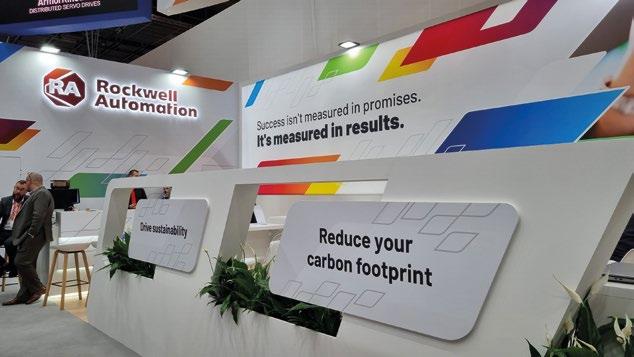

“You need a range of skills to successfully implement and utilize digital technologies, which requires a high level of expertise. So, I think in the end, it impacts all of them,” Roger described. “While digital solutions enable new capabilities and optimization of processes and production, they also require changes in processes and a change management approach usually, depending on the scale of digital transformation.”
Increased productivity and efficiency
In many organizations, data is often stored in separate silos, such as separate databases or software systems. This can create inefficiencies and make it difficult for different teams to collaborate and share critical information. However, by investing in cloud-based systems and integrated software platforms, these data silos can be broken down, allowing for better sharing of insights, more informed decision-making, and improved performance.
“Producers need to find new ways to decrease costs and boost productivity,” Roger stated on the topic of innovation in a growing digital landscape.
One of the ways this can be achieved through digital operations is with the utilization of augmented reality tools. These tools allow for remote commissioning, where maintenance and repair work can be conducted and discussed from anywhere in the world. Experts can easily access and share data remotely, resulting in significant cost savings. Additionally, augmented reality tools can be used for guiding workers through different maintenance or troubleshooting steps. This not only increases the quality of their work, but also safety. At the same time, less skilled workers can be utilized to perform the required work steps supported by connected remote experts.
“Travel restrictions during the COVID-19 pandemic made on site machine maintenance and also factory acceptance tests challenging. Digital tools that connect local machines and workers with remote experts helped solve some
of these challenges and their large benefits remain even in a post-pandemic time,” Roger emphazised.
Rockwell Automation’s cloud-based wireless software platform enables Premier Tech Chronos, an Italian processing and packaging machine builder, to share vital diagnostic information with customers to enable predictive and preventative maintenance activities, accessible via mobile technology. The capabilities can range from flagging issues to fulfilling orders and scheduling maintenance. As a result, machine health and maintenance can be better tracked and improves overall performance.
Another way to increase productivity is with robotics technology, which enables greater productivity and efficiency through packaging operations, leading to improved productivity within the workforce, as well as addressing the potential shortage of skilled workers.
Additionally, Rockwell Automation’s iTRAK system overcomes the limitations associated with conventional manufacturing methods. It allows for independent control of the machine’s magnetically propelled movers and facilitates automatic changeovers, thereby reducing the need for system restarts. This technology creates opportunities for automated processes, which can relieve the workforce and improve speed and accuracy that aligns with today’s packaging production needs.
33 Packaging Europe
As with many other industries, packaging manufacturers are seeking to digitize their operations. Although not an entirely new concept, it is yet to be adopted across all operations in packaging manufacturing as organizations look to prioritize opportunities that enable immediate return on investments and promote long-term growth.
Improved product quality
Digital solutions can provide prototyping capabilities, saving time and money that would otherwise be wasted on producing an entire machine or production line only to discover flaws that require starting over again.
Traditionally, machine builders built and assembled physical prototypes to test the machines and to identify potential issues, now with virtual prototypes manufacturers can test their functionality and evaluate their suitability before committing to large-scale production. This process also enables manufacturers to quickly identify potential design issues early on, ensuring that the final product meets the required quality standards, avoiding costly production mistakes down the line.
“You can design the machine or even the whole production line virtually and you don’t have to build a prototype, which would cost money and time,” Roger explained.
Facilitating collaboration between designers and manufacturers, Roger continued that you can “visualize the product, show it to potential customers, and jointly discuss potential changes or improvements.” This would allow for enhanced customization especially concerning clients that request package-ondemand services.
Driving sustainability
The rise in package-on-demand orders has led to an increasing need for packaging machines to be more flexible to adapt to requests and changes without delay, whilst maintaining quality and limiting unnecessary waste.


AI algorithms can generate optimal packaging designs that are customized to fit the specific product and minimize excess space, saving on unnecessary packaging material waste and costs. This may not seem like significant cost savings on a per-order basis, but according to Roger, the cumulative cost savings and sustainability metrics over the course of a year can be quite substantial.
Another way sustainability is being realized in this transformation is through inline quality control. Image recognition, for one, is allowing manu-


facturers to minimize the amount of waste generated during production and reduce the organization’s overall footprint.
“Machine learning tools are able to detect damaged containers or misplaced labels, and then loop it back into the control system to improve the process so that you have less waste,” Roger discussed.
Thirdly, the Internet of Things (IoT) can greatly improve processes at a machine level, by enabling real-time monitoring of machines. IoT can encourage good waste management and reduction of energy costs by providing realtime data on production lines and equipment. With this data, manufacturers can identify and address inefficiencies (e.g. determine the amount of energy consumed during the production process), optimize operations and reduce waste. One way this can be achieved is through sensors, Roger stated.
“Working in the past with customers, we’ve found success in investing in smart sensors for crucial components in packaging machinery. This sensor data allows for detecting any anomalies and even predicting remaining lifetime to optimize maintenance and extend lifetime.”
Prioritizing opportunities and investments

With all that being said, digital solutions should not be viewed as a silver bullet. Digital solutions are just a tool to achieve a desired business outcome. Organizations should therefore thoroughly assess and analyse exactly what it is they want to get out of digitalizing their operations.
“I think it’s important to really start with the business objective and then define a clear strategy around that,” Roger discussed. “With digitalization being such a wide field, go for the low-hanging fruit – where there is relatively little investment, but a huge impact.”
In terms of calculating return on investment and defending digital investments in front of a board, Roger explained that it is a matter of quantifying the reasons:
“Often it’s relatively straightforward to quantify or at least estimate the increase in availability, quality, throughput or decrease in energy consumption that digital solutions enable. In these cases, the return on investment of the digital solution can easily be calculated. In other cases, it is not that straightforward. For example, solutions that reduce risks such as cyber security threats or food safety incidence as the financial impact of such incidents as well as the probability of them happening are not straightforward to quantify.”
Conclusion
The digital transformation in packaging manufacturing is bringing about a wave of innovative changes that can significantly improve old processes and shape the industry’s future. This is being achieved through transparency, the breakdown of data silos, enhanced customization, and improved product quality. That said, it is important that packaging manufacturers conduct a thorough assessment of their business goals and capabilities and prioritize the digital applications that best align with them before making an investment. n
34 Packaging Europe
CIRCULAR PACKAGING AND HUMAN RIGHTS
Circular economy strategies, including recyclability and recycled content targets, is part of many brands’ sustainability and packaging strategy. These voluntary targets are becoming increasingly mandatory as we see an increase in legislation prescribing or incentivizing the use of recycled material. The mandatory targets have global reach and come in degrees of ambition.
Zooming in on plastic, recycled content targets include 30% for plastic bottles in the UK, 50% for plastic bottles in California by 2030, or 30% for all plastic packaging in South Africa by 2027. This pattern is expected to scale as the final negotiations for the EU Packaging and Packaging Waste Regulation are concluding, and the talks on the UN Plastic Treaty are moving ahead.
Voluntary and mandatory targets are increasing demand for recycled plastic and thus – if market mechanisms work and are supported where needed – the collection and recycling of plastic waste. Procurement teams will spend more time looking for recycled plastic and they will be looking globally, including the Global South, as localized collection and recycling will not meet the demand. The global sourcing of recycled plastics is already happening today. Plastic bottles collected and (partially) recycled in Indonesia for example are finding their way into water bottles on European grocery shelves. The global connectedness of plastic recycling will increase alongside the demand for recycled plastic.
Recycled plastics and social injustice
In a globalized recycled plastic market companies are sourcing recycled plastic carrying social injustice and human rights abuses. Why is that? Any material collected and valorized in the Global South or far Eastern Europe will have

been handled by waste workers, who live on the breadline. Although being an essential contributor to the circular economy, they are far away from benefitting from a scaled-up marketplace of circular plastics.


As a purchaser from the Global North, it is crucial to understand the lack of integrated waste management systems in these regions. Where waste is collected and treated, it is done by flexible, savvy and endlessly hustling workers and entrepreneurs – with limited to no government support. This design offers opportunities for many but is also riddled with injustice and exploitation. The supply chain of recycled plastic relies on waste pickers, collectors, and waste yard workers who face a plethora of issues from a human rights perspective. Incomes often do not secure a living and can be below the cut-off point for extreme poverty, set by the World Bank at 1.90 USD/day. The higher up you move in the value chain, the higher incomes become. For example, the ‘small bosses’ on an Indonesian dumpsite earn twice to triple that of the waste pickers they organize.
A lack of alternatives is especially prevalent for societies’ most vulnerable groups, leading them into waste work: children, immigrants without legal status, ethnic minorities, members of low caste or class, and women often end up doing the least well paid jobs. Workers suffer from social stigma, resulting in discrimination, extortion, and violence (including from government representatives). The majority of the work is done informally, resulting in a lack of protection and government support. There is a clear hierarchy, especially where informal recycling is organized around dumpsites, again leading to extortion and violence not only from external parties, but also from within the communities. Unfree work relations are prevalent, which contributes to cases of modern slavery. Additionally, there are occupational health risks, including direct injuries (e.g. cuts, bites, heavy
35 Packaging Europe
Alina Marm, a PhD researcher at the University College London and a sustainability leader in the packaging space, explores why we must pay attention to human rights when scaling recycled content – and how we can do so.
bruising), sickness (e.g. eye infections, diarrhoea, respiratory diseases), and long-term effects resulting from exposure to toxic working conditions, often for decades.
The direct sourcing link between the different geographies and the conditions under which the material is recovered and valorized connect the European recycled PET bottle to an immense degree of human & labour rights violations and social injustice.
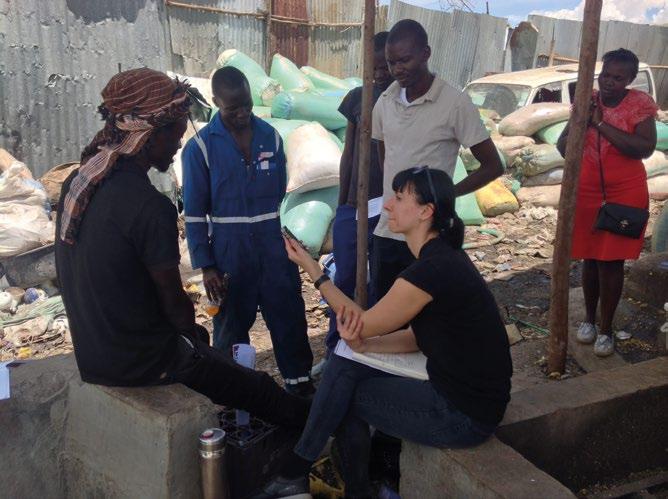
of the supply and the active involvement of the buyer. At first, this might sound like a mammoth task. However, many of the mechanisms needed for partnerships in this setting are tools well known to the strategic purchasing community: co-investments, training, off-take guarantees, and prices that make all thrive. However, it will need some rethinking on how to operationalize these mechanisms.
Firstly, the design of the partnership has to be co-created. Co-creation starts with deliberate inquiry and listening to what the sourcing partners need and how the system works currently, as well as creating clarity and transparency on what the buyers need. Based on these insights the stakeholders can build an operating model that fits the context.
Secondly, partnerships are not drive-by-interventions. They succeed if there is community ownership with co-accountability. The community of waste workers needs to be in charge while the sourcing company needs to remain accountable for the long-term success.
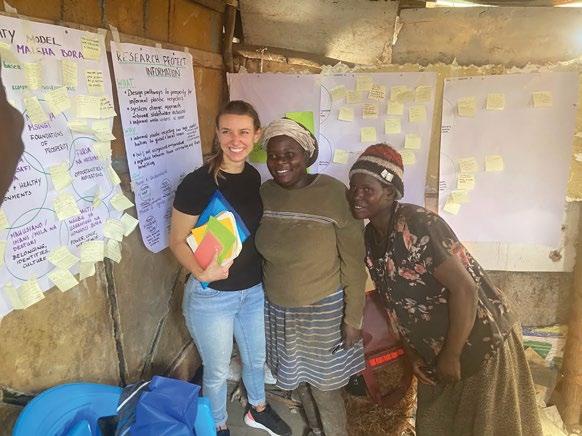
Paths towards a solution
Does this mean sourcing from these markets is not an option? No, this would be a lost opportunity – for the buyers of recycled plastic and the (informal) waste workers and entrepreneurs.
We need a change in sourcing strategy, away from spot deals that are blind to the conditions along the supply chain to one of stakeholder-inclusive and strategic partnerships which create win-wins.
Buyers win: Building partnerships provide access to increased quantities of recycled plastic. In addition to what is already captured, plenty of material is currently not collected or sorted. Recycled material from these markets today is often down-cycled. There are, however, relatively easy quality gains to be achieved all across the value chain. These can result from small interventions such as increasing the fractions sorted or improving the machines used to process material. Furthermore, removing current market inefficiencies releases financial gains that can be reinvested in the partnership.
Waste workers win: Done right, this creates prosperity through decent jobs that provide a living for the workers and their families, equity and active inclusion, respect, clean and safe environments, opportunities for entrepreneurship and upward movement. These partnerships can also have the power to convince governments that supporting waste management and recycling is worth its while – especially on city and municipality levels.
While each supply chain configuration will differ slightly, partnerships need to be built on a direct connection to the stakeholder at the beginning
Lastly, it creates conscious equity creation. Equity is achieved if the disadvantages of the sourcing partners are recognized and accounted for. These disadvantaged usually result in the additional hurdles that the sourcing partners will have to overcome and providing active support is essential. Not because they are not smart and ambitious, but because there is a level of disadvantage that is difficult to outsmart and outrun. Common hurdles include access to financing, permits, and basic infrastructure as well as access to decision-makers and knowledge holders.
Companies sourcing recycled plastic will not be forced to source globally. They can stick to the known local markets. But if they are sourcing along the Global South-Global North axis, partnerships will be needed to create quantity, quality and adhere to human rights. Turning a blind eye to human rights violations in the supply chain should not be an option for a responsible business, and it will become harder to do so. Legislation is forcing companies to look at their supply chain and will request action. The German Supply Chain Due Diligence Law is the farthest reaching yet but builds on Norway, England, and France. Among others, the EU, USA and Brazil will follow. Even if a company in question is not subject to these laws, it will feel the focus of attention on human rights and, with it, the need to show awareness and action.
We are at an intersection of increasing circularity, heightened attention and action on human rights and social justice, all integrated into business realities. All three can be combined for the better. This is good news. n
36 Packaging Europe
The supply chain of recycled plastic relies on waste pickers, collectors, and waste yard workers who face a plethora of issues from a human rights perspective.
A DEEP DIVE INTO PACKAGING SUSTAINABILITY WITH UNESDA SOFT DRINKS EUROPE
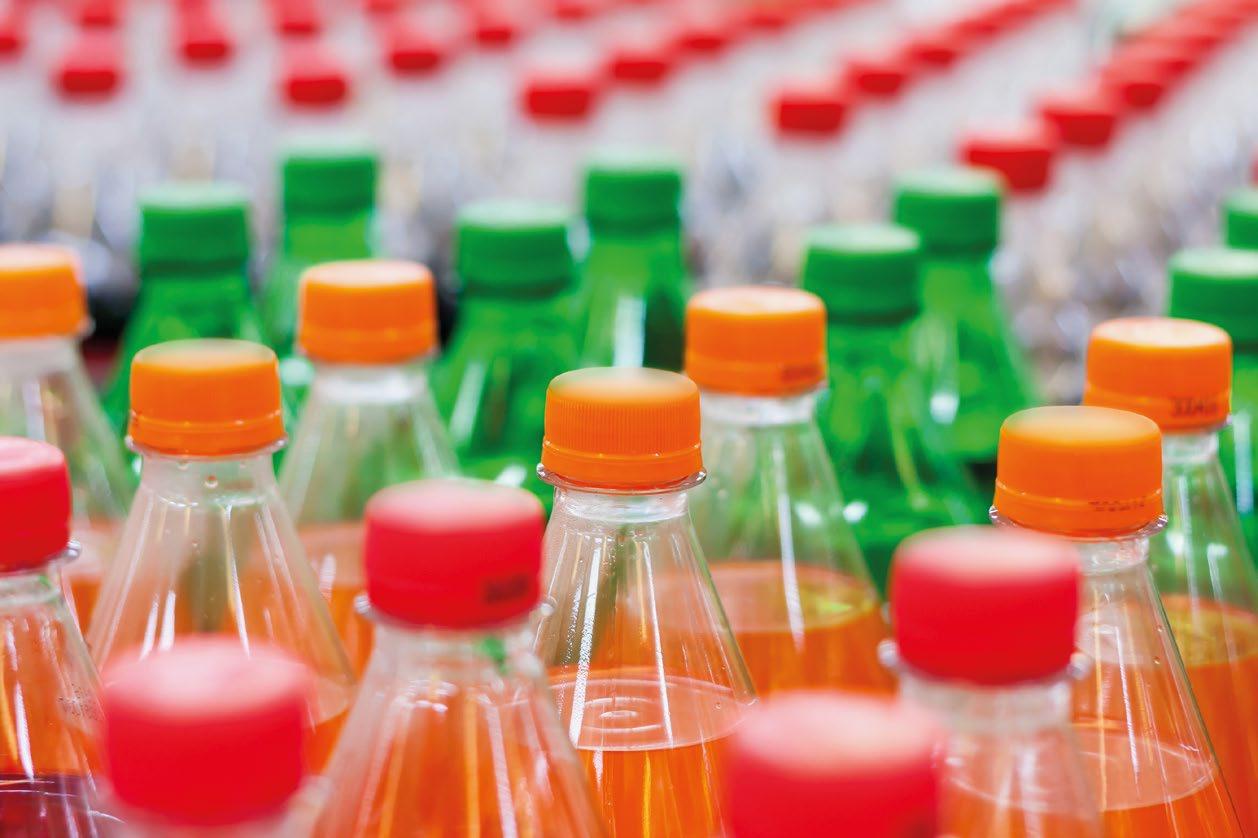
UNESDA Soft Drinks Europe represents the interests of producers of soft drinks across Europe. In 2021, the association launched its circular packaging vision for 2030. Elisabeth Skoda discusses the state of the drinks and drinks packaging market, as well as progress on the plans and goals for the future, with UNESDA’s Director General Nicholas Hodac.
ES: For the benefit of our readers who may not be so familiar with UNESDA, could you tell me a bit more about the association and its mission?
NH: UNESDA Soft Drinks Europe represents the European soft drinks industry, with two types of members: Corporate members with companies like Coca-Cola, PepsiCo, Red Bull, etc, and national associations; every country around Europe has a soft drinks or beverage association, and almost all of these are members of UNESDA.
The mission of UNESDA is to represent the interests of our members, and we mainly focus on two types of issues – the sustainability of our packaging and the health and nutrition aspect of our drinks.
ES: Today we’ll focus on the packaging side. How would you describe the state of the drinks packaging market right now, with regard to sustainability and packaging materials used?
NH: I would like to start with an optimistic view: It is a very exciting environment to be in, because we are seeing a lot of investment towards circular packaging. It is exciting from a business perspective to be investing in sustainability to such an extent, but it is also very exciting for consumers.
It is also very challenging. There are concerns about waste and pressure to improve the collection rates of our packaging.
We are also facing several EU mandatory targets, including to use recycled content in our packaging, which we have to comply with in a very
difficult market environment, where the prices of recycled content material are higher than virgin material. That’s obviously putting lots of pressure on our goals to achieve full sustainability.
ES: UNESDA set itself ambitious packaging sustainability targets – could you talk us through the aims of these targets for 2025 and 2030?
NH: When we embarked on this new journey, a brave new chapter for our industry, the goal for us was to make a very clear commitment to ensure that our packaging is a valuable resource and should never be wasted.
Now with that in mind, we launched our vision for circular packaging by 2030, which is around four pillars. The first one is recyclability. We have set the goal of achieving 100% recyclability by 2025.
Secondly, collection has to be improved. We have set a goal of achieving over 90% collection of all of our packaging by 2030 – not just of plastic bottles, as required by EU law, but also of aluminium cans and glass bottles.
Thirdly, we are also making a commitment to increase the use of recycled content. Going well beyond EU legislation, we have committed to do 50% of recycled content in PET bottles by 2025, and are aiming to achieve 100% of recycled content and/or renewal material in 2030.
Finally, there is the important pillar of reducing and reusing. We have made a commitment to increase the share of reusable systems, and in order to guide us on this journey we have commissioned studies on the economic cost and the environmental impact of increasing the share of reusable packaging. A PwC
37 Packaging Europe
study for UNESDA estimates a cost of more than €16 billion to achieve 10% refillable PET by 2030 in the EU. This study shows us that reusable beverage packaging has additional environmental costs if we compare it to single-use recyclable packaging, due to a great number of factors, eg. building new bottling lines, increased energy consumption from operating additional machinery and washing bottles, additional storage space, and higher fuel consumption from increased logistical complexity for example.
ES: 2025 and 2030 are still a little way off – how far along are your members at the moment in this journey towards your goals?
NH: They are taking these commitments hands-on, and already today are making very positive progress towards these, for example in the area of increasing collection rates around Europe. Recently, Latvia and Slovakia have introduced new deposit return schemes, which exist thanks to the investments and the commitments of our members.
They are obviously investing and making sure that we will have more deposit return schemes around Europe very quickly, and so that we can achieve the 90% collection target before 2029 (for plastic) and 2030 (for all packaging).
We are seeing commitments and announcements by our members. For example, Coca-Cola committed to achieving 25% reusable packaging by 2030 globally; and PepsiCo’s recent announcement to double the percentage of all beverage servings it sells delivered through reusable models from 10% to 20% by 2030.

Finally, when it comes to recycled content, we had announced to achieve 50% recycled content by 2025. We still have a long way to go, but already today, in several countries around Europe, our members are bringing to the market bottles made out of 100% recycled content. We continue to make further progress, as the first progress report on our commitments shows: for most of our
corporate members, more than 96% of their packaging is now fully recyclable, and around 33% of our PET bottles sold in the EU already use a minimum of 50% recycled PET.
Clearly, the journey has started, and we are driving it full steam ahead.
ES: You mentioned deposit return schemes – what are the challenges and the barriers to setting them up, and how could they be boosted more in countries that maybe don’t have them at the moment?
NH: We see a significant role for deposit return schemes around Europe. Unfortunately today, many countries have very low collection rates, so significant change is needed.
So we are in favour of a wider rollout of deposit return schemes around Europe, because if you want to achieve the 90% targets, and actually, by EU law you already have to achieve 77% collection of PET bottles by 2025, this will not be possible without deposit return schemes in several countries.
The barriers are twofold. First, there is a significant investment barrier, as these schemes come with a high cost. Significant investment is required from our industry, and big investments are made to make this possible.
Secondly, there has been a lack of guidance at a European level on how such a scheme should be developed. In the meantime, the European Commission has proposed EU legal minimum requirements for Deposit Refund Systems in the EU Packaging and Packaging Waste Regulation. We see it as a positive move, even if we think that there are some key elements that are missing and that should be considered. For example, to achieve full circularity, a mechanism should be put in place to guarantee that beverage packaging collected via the DRS is recycled and used again in priority in new beverage packaging in a closed-loop recycling system. This mechanism will prevent our packaging from being turned into other non-food products, as is currently the case with 69% of our PET bottles.
38 Packaging Europe
”
We see a significant role for deposit return schemes around Europe. Unfortunately today, many countries have very low collection rates, so significant change is needed.
ES: This also ties in with different collection models for packaging waste. How do you think those can be re-improved?
NH: When you look at existing EPR (Extended Producer Responsibility) schemes, one example that works well is the blue bag scheme in Belgium, achieving high collection rates.
Several of the other schemes around Europe have very mixed collection rates, and we have come to the conclusion that, if we are to meet our collection targets at a European level, tweaking these systems will not be sufficient; which means that in some countries, a deposit return scheme will be necessary.
Fortunately, in the large majority of countries that have a deposit return scheme, they are well-designed, they work well, and achieve very good results.
ES: Is there anything that could be done from a legislative point of view, to improve the situation overall, across the EU or in individual countries?
NH: It is maybe not very often that the industry calls for legislation, but here it is clearly needed.
We believe that, at a European level, through pieces of legislation – such as the EU Packaging and Packaging Waste Regulation – creating minimum requirements for deposit return schemes is a good guidance tool.
This is something that we have advocated for, together with our friends within the NGO community, for example Zero Waste Europe. We have come together because we see the added value of such schemes, and the importance of introducing minimum requirements.
ES: Looking at packaging materials, what are the barriers to fully closing the loop when it comes to PET packaging, and how can these barriers be overcome?
One of the main challenges is that there is actually no mechanism or legal framework today that requires the loop to be closed. Therefore we find our bottles in textiles, toys or tyres, and we think that it’s not the best use of bottles.
We are calling for a legal framework which will close the loop, and will offer the opportunity to those within the loop, in this case, the beverage producers, to buy back the recycled content via a priority right or a right of first refusal.
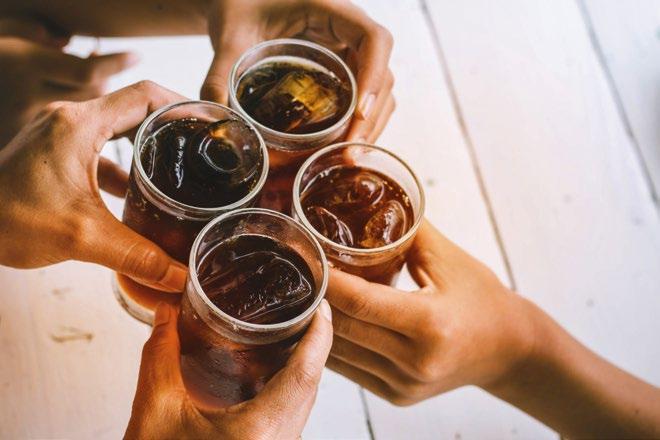
An additional reason why we believe this is important is that it is the only way to give an incentive to other sectors to invest in their own products’ collection and recycling.
We think that doing this will send a very strong signal to others that they also have to invest in circularity.
ES: Beverage packaging is not just PET, there’s also glass or metal. What are your thoughts on using those more, or do these materials come with their own problems when it comes to closing the loop?
NH: Each packaging material has a role to play, and we do not see it as a competition between one or another. Depending on the type of consumption, a glass bottle will be more convenient than a plastic bottle; in other cases, it will be an aluminium can; and we see that consumers are asking for different types of packaging.
What is important for us is to make sure that each packaging individually achieves circularity. It is not a question of playing one against the other, but about making sure that the pack is used in the most environmentally friendly way, so that the environmental footprint is always as low as possible.
ES: In conclusion, what would an ideal beverage packaging world look like for you – if there is such a thing?
NH: I am confident there is such a thing. I am confident that the vision we have set out will get us there. If you take a step back and think about the notion of sustainability and circularity, in a couple of years from now we will have a product which is 100% recyclable; which is more than 90% collected; and is made from 100% recycled and/or renewal content.
I think that’s the definition itself of circularity. That is the ideal packaging that we are working towards, and I’m confident that we can get there. n
This article is based on a podcast interview. To listen to all the latest Packaging Europe podcast episodes, go to https://packagingeurope.com/ sections/podcasts.
Nicholas Hodac UNESDA’s Director General

39 Packaging Europe
A DEEPER EXPLORATION OF SELF-ADHESIVES
Fedrigoni Self-Adhesives was formed following the merger of Ritrama, Arconvert, Manter and Acucote – creating a division that is specifically focused on the design and production of self-adhesive materials. We ask Fernando Giron, Fedrigoni Self-Adhesives Commercial Director, about the key drivers of innovation in the sector and take a look ahead to potential future developments in this edition of our ‘In Conversation With…’ feature.
Fedrigoni Self-Adhesives is a relatively young company – could you tell us more about how it was created, and what its core areas of expertise are?

The Fedrigoni Self-Adhesives business unit, involved in the design and production of self-adhesive materials, was created from the merger of some of the leading companies in the sector, such as Ritrama, Arconvert, Acucote and Manter. With 14 production plants and 24 slitting and distribution center worldwide, Fedrigoni Self-adhesives serve markets ranging from food labels to pharmaceutical and visuals communication.
We provide our customers with the support in choosing the right type of paper or materials for their self-adhesive projects, including wine and spirits labels, gourmet food and premium cosmetics labels, designer labels and special projects. A booming sector, where skills and creativity, communications and technology converge.
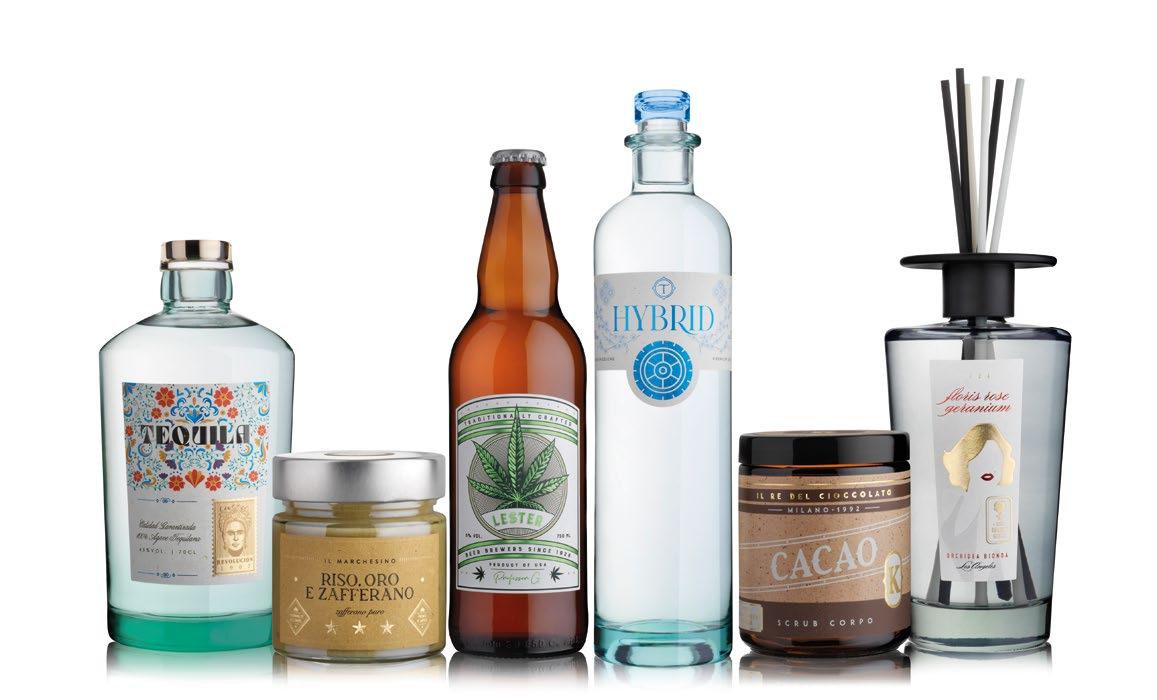
40 Packaging Europe
I’d like to get your thoughts on some of the key trends for self-adhesives within different packaging sectors. Let’s start with the pharmaceuticals sector – what are the key drivers of innovation here, from Fedrigoni’s perspective?
As you know the pharmaceutical sector is the most demanding technically. More and more products in the industry request extreme service temperature (deep freeze at -80 degree C and Cryogenic -196 degree C), combined with demanding sterilization processes. The adhesives we use need to perform better and better to cope with this new trend. Another trend that we are seeing is the request for more advanced safety feature incorporated in packaging, we see for example more and more requests of void labels. Little by little we can see first steps in the right direction on environmental topics, the industry will move in that direction in the coming years for sure.
And how about wine and luxury – what is driving innovation in those particular sectors?
Innovation in wine is driven by three main pillars: sustainability, advanced technical solutions that improve the wine label performance, and last but not least, new textures/colours that help brand owners to differentiate their brands from competitors.

Fedrigoni Self-Adhesives is fully committed to the three topics as shown off by our last product launches, which include 100% recycled papers and the innovative Re-Play range that upcycles up to 20% of the liner waste into the new premium facestock, new technologies to improve opacity and reduce wrinkles caused by humidity and condensation, a new range of papers for neck label application, as well as the introduction of new and creative Fedrigoni papers never seen before in the wine label industry.
Let’s move on to home and personal care. What do you see as the key trends in this sector currently?
Home and personal care brand owners push to find increasingly sustainable solutions. Wash-off adhesives for PET containers and PE mono materiality projects are everywhere! With the help of Recyclass recyclability of plastic packaging in Europe is getting structured and we are able to offer certified packaging based on scientific protocols. Many new concepts to proceed in that direction will emerge and Fedrigoni for sure will be part of it!
Looking ahead to the future – what will the selfadhesives sector look like in five years’ time? Do you predict any significant changes from what it looks like now?
The self-adhesives sector is likely to experience significant growth and evolution over the next five years. Some possible trends and developments include:
1) Increased demand for sustainable and environmentally friendly self-adhesive products: With a growing global focus on sustainability and reducing environmental impact, consumers are becoming more conscious of the products they use. This trend is likely to lead to an increased demand for self-adhesive products that are made from sustainable materials and are recyclable or biodegradable.
2) Advancements in adhesive technology: The self-adhesives sector is continually exploring new technologies to improve the performance of adhesives. In the next five years, we can expect to see advancements in adhesive technology, leading to more durable and versatile self-adhesive products.
3) Growth in the digital printing market: Digital printing technology has revolutionized the printing industry, and the self-adhesives sector is no exception. The use of digital printing for self-adhesive products is likely to grow significantly in the next five years, as it offers increased flexibility and customization options. n
41 Packaging Europe
MCKINSEY AND NIELSENIQ REVEAL BROAD CORRELATION BETWEEN ON-PACK SUSTAINABILITY CLAIMS AND CONSUMER SPENDING
McKinsey and NielsenIQ have undertaken a joint study examining the relationship between ESG-related claims made on product packaging and consumer spending habits in a bid to identify the ways in which companies can balance sustainability-minded progress with commercial success – revealing that multiple claims can encourage uptake in sales.
Consumers seem to be expressing their own interests in sustainability; a US consumer sentiment survey conducted by McKinsey in 2020 saw over 60% of respondents claim that they would pay a higher price for a product packaged in sustainable materials, while NielsenIQ’s more recent survey saw 78% of US consumers state that a sustainable lifestyle is important to them.
Apparently, CPG executives tell a different story. Many report that their ESG initiatives have not been able to generate sufficient consumer demand, and that new products launched in line with their sustainability goals are not selling as well as initially anticipated.
In an effort to reconcile these conflicting accounts, McKinsey and NielsenIQ took to examining consumers’ spending behaviour – aiming to
provide CPG companies with the relevant statistics for bringing ‘environmentally and socially responsible products’ to market in line with their ESG strategies and commitments.
The process
From the outset, the study clarifies that the statistics of products’ sales growth do not inherently reflect the motivation behind consumers’ spending decisions. For instance, although products making ESG-related claims apparently averaged a 28% cumulative growth over the past five years, as opposed to the 20% growth for products that do not make such claims, there is no way of knowing whether consumers chose to buy a product for its reported sustainability benefits or another reason entirely.

42 Packaging Europe
McKinsey also stresses that the ESG-related claims in question were not independently verified for the purposes of this study. While both companies state that ‘greenwashing’ impacts consumers’ view of and engagement with businesses, potentially putting companies at risk, the goal of the study is not dependent on the validity of the claims; it examines their correlation with purchasing behaviour and sales performance, and does not control marketing investments, distribution, promotional activity, or other such factors. The social and environmental benefits of putting the claims into action were not considered, nor were the incremental costs of such implementation.
To generate the results, McKinsey and NielsenIQ worked together to analyse five years of US sales data between 2017 and June 2022, comparing the growth rates of products that made ESG-related claims and those that did not. The data covered 600,000 individual product SKUs representing $400 billion in annual retail revenues from 44,000 brands across 32 food, beverage, personal care, and household categories. It was occasionally paired with a household panel conducted by NielsenIQ, which tracks the purchasing behaviour of consumers in over 100,000 US households.

Ninety-three ESG-related claims – the likes of ‘cage-free’, ‘vegan’, ‘ecofriendly’, and ‘biodegradable’ – were divided into six classifications: animal welfare, environmental sustainability, organic farming methods, plant-based ingredients, social responsibility, and sustainable packaging. Factors such as brand size, price tier, and the age of the product – i.e., whether it was new to the market or previously established – were controlled during the study.
The results
Generally speaking, there was a ‘clear and material link’ between sustainability claims and consumer spending. Although ESG-related claims did not always equate to uptake in sales, the results of the study reveal that, in the cases studied, consumers were transitioning their spending towards products making such claims; that growth was not generally affected by the size
of a brand, but that smaller brands may be considered more trustworthy or worthy of investment; that less common ESG-related claims tended to see a larger impact, but consumers are not displaying a preference towards any one claim; and that a combination of claims could create the impression of authenticity amongst consumers.
Each product’s initial share of sales in its category over the five-year period was noted, as well as its five-year growth rate relative to that share. This revealed that, overall, products making one or multiple ESG-related claims on their packaging were outperforming products that did not, suggesting that claims to sustainability were, at least in part, influencing consumer uptake.
It is thought that, within the five-year period, ESG claims have influenced 56% of all growth, which is reportedly an 18% increase from the beginning of the timespan. Furthermore, products making ESG-related claims are said to have a 1.7 percentage-point advantage in CAGR over products without them, with the ‘sustainable’ products accounting for almost half of all retail sales in the categories examined.
Even so, the growth varied between categories. In 11 out of 15 food categories and three out of four personal care categories, products making ESG-related claims generated outsize growth. For beverage categories, only two out of nine saw such growth. The report emphasises that the data alone cannot fully explain the variation in purchasing decisions, which could have external explanations that vary on a case-by-case basis; for instance, variation in children’s formula and nutritional beverage purchases could be influenced by medical advice.
Regardless, two-thirds of categories saw faster growth in products that made ESG-related claims. According to NielsenIQ’s household panel, demographics such as higher-income households, households with children, and urban and suburban residents are more likely to invest in products making claims to sustainability, yet the research sees an average of plus or minus 15% deviation across demographic groups such as age,
”
Overall, products making one or multiple ESG-related claims on their packaging were outperforming products that did not, suggesting that claims to sustainability were, at least in part, influencing consumer uptake.
race, incomes, life stages, and geographies in the purchase of products bearing ESG-related labels.
Nor was growth limited to brands of a particular size; 59% of all the categories studied saw the smallest brands making ESG-related claims undergo disproportionate growth – yet this was also true of the largest brands in 50% of categories. The underperformance of medium-sized brands cannot be explained by the data, according to the companies, but it is speculated that these brands do not match the perceived trustworthiness of smaller companies while lacking the marketing and wide-scale distribution of their larger counterparts.
The report also notes variance within categories – namely, that smaller brands grew more quickly for sports drinks and hair care products, whereas larger brands saw faster growth in fruit juice and sweet snacks products.
Another discrepancy that the data cannot explain is the fact that newer products making claims outperformed newer products that didn’t in only 32% of categories, while 68% of established products making claims outperformed their non-claiming counterparts. The study presents the theory that consumers are pleasantly surprised by existing brands making sustainable progress, although they may have come to expect such claims from up-and-coming brands.
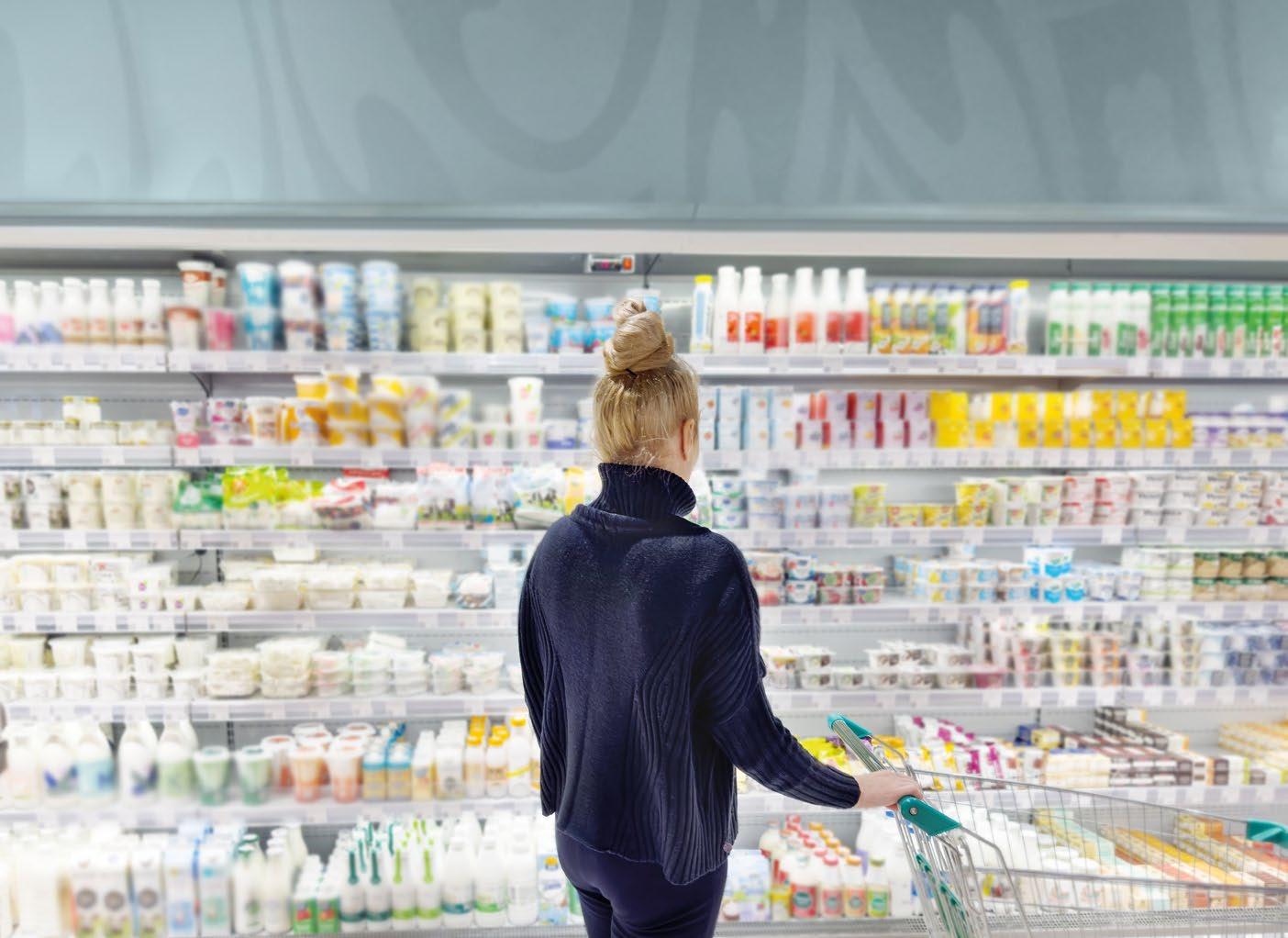
Performance rates of products making ESG-related claims did not seem
There is no evidence to suggest that any individual claim was favoured by consumers, with no specific word or phrase correlating with outsize growth. What the study did reveal was that the less prevalent claims, such as ‘vegan’ or ‘carbon zero’, grew 8.5% more than the equivalent products not making a claim; on the other hand, claims like ‘sustainable packaging’ and ‘plantbased’ saw a 4.7% growth differential, and the most common claims such as ‘environmentally sustainable’ saw a 2% growth.
While all the ESG-related claims studied led to an increase in sales, the difference seems to have been greater in less frequent claims – implying that unique claims can differentiate a product, especially if it has a disproportionate impact on a company’s ESG goals and commitments. Further still, an analysis of NielsenIQ’s household panel data indicates that the depth of a brand’s ESG-related claims has a positive association with consumer loyalty. Customers also appear to return more frequently if the ESG-related claims are consistent across a brand’s portfolio. Brands that receive under 50% of their sales from products making such claims saw repeat rates of under 30%, whereas those making claims on over half of their products saw repeat rates of between 23% and 34% – meaning that each customer purchased products from the same brand three or more times a year. McKinsey points out that this is still not direct proof that customers are purchasing the products because of their ESG claims, but it sug-
If a product’s packaging made multiple ESG-related claims, it generally categories, the growth rate saw a positive correlation with the number of McKinsey clarifies that brands should refrain from printing more claims and certifications onto their packaging than they can reasonably substanti-
”
These results indicate that sustainability-minded consumers may not always opt for the cheapest available item but may rather choose to support affordable products making ESG-related claims.
eration for brands attempting to strike a balance between differentiated growth and making advancements in their ESG commitments – the first being the establishment of an effective ESG strategy across their portfolios to match their product claims. Expanding ESG-related benefits across multiple categories and products is likely to have a bigger impact and increase a brand’s chances of achieving outsize growth, as opposed to relying heavily on a single product. Companies are therefore encouraged to identify and publicise, where appropriate, the steps they are taking that will result in the greatest ESG impact.
Moreover, they should develop a design process that embraces ESGrelated claims as well as cost engineering, according to McKinsey. A disciplined design-for-sustainability approach is expected to maximise the visibility, efficacy, and cost-efficiency of ESG-related product features that will attract consumers’ attention, as will the removal of ingredients, materials, and processes that are slowing or reversing sustainable progress. Taking a wider view of a product’s sustainable impact, its quality, and the cost of investment in product design is expected to garner positive results.
Companies are also advised to build a robust portfolio featuring both established and new ESG investments, both of which are thought to be beneficial. A flagship established product in a competitive market could gain an advantage by making ‘relevant and differentiating’ claims, while
Finally, McKinsey reiterates that it may be equally as beneficial from an incremental growth standpoint to introduce a second or third ESG-related claim to a product as it is to introduce the first one, leading to twice the gain. It recommends that companies ‘embrace the holistic, interconnected nature of ESG’ and conduct category- and brand-specific assessments to identify the best method of implementing several claims, thus displaying commitment and reliability to their consumers.
Based on the data, it is believed that companies can simultaneously pursue growth and their ESG strategies. Consumers appear to be translating their interest in sustainability into their spending behaviour, and brands can use this to their advantage while also taking meaningful action towards socially and environmentally beneficial business practices.
McKinsey asserts that customers and companies share a responsibility to mitigate the social and environmental impact of producing, transporting, and discarding products, and that factual ESG-related label claims will contribute towards a more sustainable relationship with consumer goods and their packaging. It emphasises that there is no one guaranteed route to successful investment in environmentally and socially responsible products, but asserts the importance of companies making meaningful efforts to meet their ESG commitments and communicating these to their customers, which can be achieved effectively through substantiated label claims.
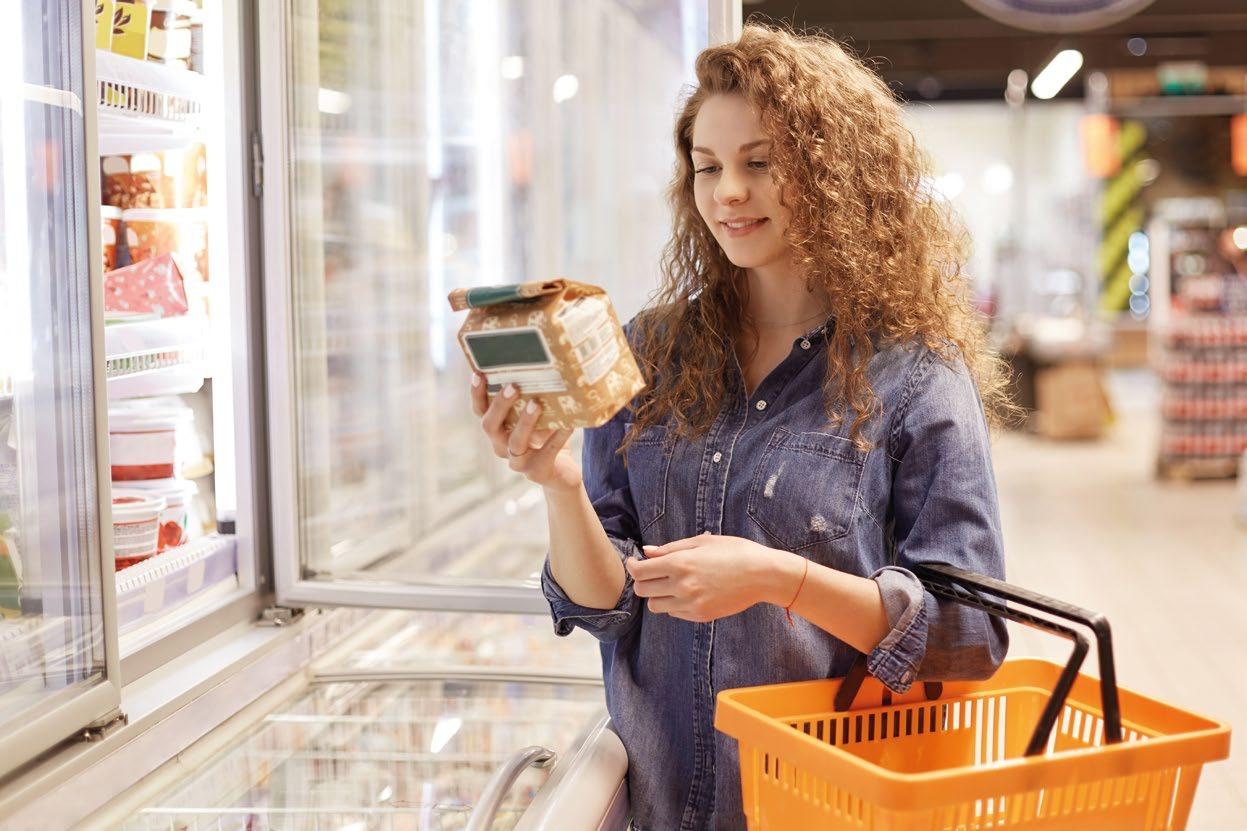
45 Packaging Europe
n
ACTIVE AND INTELLIGENT PACKAGING SPOTLIGHT

In collaboration with our partners AIPIA, we bring you the latest from the world of intelligent packaging.
POLYTAKSYS UNVEILS SMART LABEL IN BID TO PREVENT FOOD LOSS
PolyTaksys, a Germany-based AIPIA member which has previously developed Open Monitor stickers that can reveal messages over a defined time period, is now able to announce the introduction of U4FOOD Smart Labels to address the issues of food loss and waste in the refrigeration sector.
The company is offering interested industry partners the opportunity to implement their own test market in supermarkets with U4FOOD opening time control labels from the middle of this year.
The label is activated either automatically when the product is opened via the product moisture, or by manual activation. Information and recommendations for action are released in a daily sequence, over a defined time period, for example one, two or three days – each day revealing a different, more urgent message.
Depending on the rate of cooling the release of information can be accelerated or slowed down, says the company.
The Open Monitor technology allows manufacturers and producers to let packaging speak, explains PolyTaksys, creating a direct interaction between the product and consumer. The U4Food label reminds consumers to eat limited shelf-life products and in doing so ensures more sustainability, as well as giving information about the product/brand and ultimately leads to sales growth, it claims.
This test offer will be followed by further testing in markets for an individual dynamic best-before date (BBD). The dynamic BBD goes a step further, as safety buffers to the length of the shelf life are no longer needed, it believes. The monitored cold chain becomes the new dimension for food safety. Depending on the
cooling quality, the dynamic label extends or shortens the best-before date independently and automatically. These functions can be transferred for logistics tasks with RFID coupling.
The company already has the ability to scale production of the label, with five million labels per day, per machine possible, which guarantees prices in the low cent range, it says.
TETRA PAK USES SMART, CONNECTED PACKAGING FOR BETTER CONSUMER ENGAGEMENT
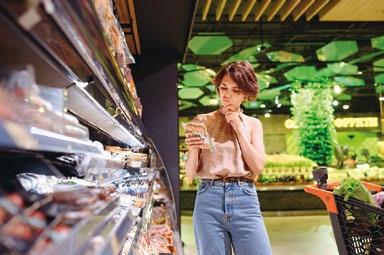

Tetra Pak has included a fun and interactive smart packaging experience on its cartons for a leading European fruit juice producer to help educate and inspire its customers, it says. The feature has been developed in partnership with creative technology studio Appetite Creative. Both are AIPIA members.
Focusing on passion fruit, pineapple, and mango flavours in the one-litre range, the smart packaging utilizes a web app-based connected experience accessed via QR codes to help customers connect to an interactive personality test. This looks to uncover the best juice drink to fit any given personality and inspire users to mix juices to create new and bespoke beverages or cocktails. The connected experience generates alcoholic and non-alcoholic recipes tailored to the results
of the personality quiz, including product preferences and the time of day a customer usually consumes the drink.
To perfect their new drink sensation, users can enter a raffle to win a Thermomix® TM6 all-in-one blender by completing the in-built quiz or sharing content on social media. Appetite Creative has designed a summer and winter version of the connected experience with seasonal-specific content that can be swapped out in real-time.
The web app tracks real-time interaction, such as buying habits, product preferences, average engagement time, age, location, scan rate, number of visitors, return visitors and social media shares, including GDPR-compliant personal data to enable the brand to optimize its marketing and better understand consumers.
The connected packaging campaign will be supported by in-store shelf wobblers and other point-of-sale (POS) materials to communicate product information to the consumers at the point of sale. Digital and social media will also be used as part of the campaign to reach more customers and increase awareness about the brand. The feature will be available from April in Austria and in Germany until the end of May.

Packaging Europe 46
UNILEVER ADDS ACCESSIBLE QR CODE TO PERSIL PACKS

Zapvision, the new Accessible QR solution for people who are blind and partially sighted, created by digital agency and longstanding AIPIA member Zappar, has partnered with Unilever so that it is now available on packs of Persil laundry detergent products across the UK.
The technology was first showcased in mid-2022 but this is the first major application of the solution.
The new, enhanced ‘Accessible QR’ codes, support more inclusive packaging by making access to information on products available to everyone whatever their visual acuity. The codes are now being incorporated for the first time on Persil’s new plastic-free capsules and Ultimate Liquids ranges and will be added to other Unilever products in the
UK and around the world later this year, it says.
The new codes, which were created in partnership with Unilever and the Royal National Institute of Blind People, can be detected from more than a metre away by the app. Shoppers will then be provided with the relevant usage instructions, safety warnings and recycling information, again through the app, via larger text or audio.
According to Unilever, the technology will soon be integrated with Microsoft Seeing AI. The major multinational hopes to work with other accessibility apps to support a global rollout of the technology.
Peter ter Kulve, president of home care at Unilever added, “Ensuring our Unilever products are accessible to everyone in society is not just an
important element of our equity, diversity & inclusion commitments – it makes good commercial sense too. With nearly two million people in the UK living with sight loss, we’ve now made one of our most loved UK Home Care brands, Persil, fully accessible to them for the first time – courtesy of the Accessible QR code!”
UPDATES TO AVERY DENNISON ATMA.IO CONNECTED PRODUCT CLOUD INCORPORATE AI FEATURES
AIPIA member Avery Dennison Corporation has announced updates to its atma. io connected product cloud, which is helping brands transform their supply chains. The platform now manages over 28 billion items for brands across the apparel, retail, food, and healthcare sectors, the company reveals.

The Spring ‘23 update to atma.io incorporates new artificial intelligence (AI) updates, including the integration of ChatGPT – an AI chatbot developed by OpenAI, launched in November 2022 – for automating alert response. As the first of many applications of generative AI on atma.io, this will enable better
collaboration and more efficient communication amongst partners within the supply chain, while ensuring privacy and data protection compliance, the company says.
Max Winograd, vice president, digital solutions at Avery Dennison explains, “The goal of using AI technologies, including ChatGPT, is to increase efficiency by reducing the time people need to spend on repetitive, manual tasks.
“Today, sourcing and supply chain managers spend a significant amount of time chasing information via email, typing out repetitive inquiries and follow-ups. With our generative AI we are
NEW VACUUM CONTAINERS TALK TO CONSUMERS
Israeli startup Silo has developed a vacuumseal container system that incorporates a builtin Alexa (Amazon’s cloud-based voice service) feature that not only keeps the food fresher for longer, but also reminds consumers to use stuff already stored in their fridges.

The smart containers keep food fresher and longer (by sucking out the air) and also include built-in tags which connect to the Alexa devices and track what they are holding. They deliver notifications on when items might spoil, telling the owners when to eat the food before it spoils. It even has a mobile app to manage the fridge while people are on the go.
By simply saying ‘strawberries’, for example, this plasticware automatically knows how many days it can host the produce before it goes bad.
The patented deep vacuum system slows down food spoilage caused by oxidization and bacteria, according to the company. The food is put in the container which is then placed on a countertop device and gently pressed down. This activates the vacuum process which happens from ‘the bottom up’ through the airway system which causes the air to be sucked from the bottom and up the airways on the side of the container and then out the top. The Silo system is both dishwasher and microwave safe, and can ensure that groceries and dinner leftovers last two to five times longer than the average Tupperware container, it claims.
When the container is placed on the device it immediately identifies the tag. Next, the device’s automated scale technology measures the
helping to speed up this process significantly, while maintaining the trusted, human connections among partners in the supply chain.”
While this is the first release of generative AIdriven capabilities, the atma.io team is working on a number of additional capabilities, such as natural language queries on the large datasets the platform manages, as well as content creation for consumerfacing experiences, and intelligent, personalized notifications. These additions will be rolled out gradually over the course of the year to enable customers to benefit first-hand from the continuous advancements in generative AI.
contents. Alexa will then ask which food product is inside it. This information is then logged so that Silo’s smartphone app can communicate how much of the product is left and also how long it will remain fresh enough to eat. The app will also remind consumers when a particular product is running low and needs to be replenished, or if they are buying too much of a particular item.
Packaging Europe 47
n
STATISTICS SPOTLIGHT
Hive is a brand-new set of tools created by Packaging Europe that aims to help packaging professionals know more about the industry they work in, offering briefings, reports, digital live events and a cuttingedge data tool, coming soon to packagingeurope.com
To give our readers a flavour of what to expect from Hive, we are sharing some statistics insights in Packaging Europe magazine – this time, with a focus on return and recovery rates for deposit return schemes and packaging waste.
Return rate of product materials for deposit-return schemes
The chart below showcases return rates for glass, plastic and metal packaging for deposit return schemes for countries that already have these schemes in 2020.
Recovery rate for packaging waste
This chart displays recovery rates for glass, plastic and metal packaging waste in 2020.
RETURN RATE OF PRODUCT MATERIALS FOR DEPOSIT-RETURN SCHEMES
RECOVERY RATE FOR PACKAGING
48 Packaging Europe
WASTE Source: EPA Network - Interest group on Plastics, Reloop - Global Deposit Book 2020, Eurostat Source: EPA Network - Interest group on Plastics, Reloop - Global Deposit Book 2020, Eurostat Austria Austria Croatia Croatia Czechia Czechia Denmark Denmark Estonia Estonia Finland Finland Germany Germany Iceland Iceland Ireland Ireland Lithuania Lithuania Netherlands Netherlands Norway Norway Sweden Sweden Switzerland Switzerland 76% 75% 71% 89% 78% 80% 133% 88% 85% 94% 76% 80% 100% 80% 98% 89% 96% 79% 74% 65% 102% 90% 84% 87% 97% 87% 71% 88% 51% 87% 36% 90% 19% 57% 80% 97% 80% 99% 87% 84% 96% 87% 96% 88% 85% 85% 100% 85% 85% 85% 97% 85% 98% 92% 85% 93% 93% 55% 95% 81% 75% 93% 93% 25% 90% 64% 90% 98% 99% 84% 89% 85% 86% • Glass Packaging • Plastic packaging • Metallic packaging • Glass Packaging • Plastic packaging • Metallic packaging 95%
14-15 NOVEMBER, AMSTERDAM
REGISTER FOR EARLY-BIRD TICKETS FOR THE AIPIA WORLD CONGRESS 2023 SCAN ME!


14-15 NOVEMBER, AMSTERDAM
REGISTER FOR EARLY-BIRD TICKETS FOR THE SUSTAINABLE PACKAGING SUMMIT 2023

SCAN ME!

































































































